
Genius Makers: The Mavericks Who Brought A. I. To Google, Facebook, and the World
by
Cade Metz
Published 15 Mar 2021
TIMELINE 1960—Cornell professor Frank Rosenblatt builds the Mark I Perceptron, an early “neural network,” at a lab in Buffalo, New York. 1969—MIT professors Marvin Minsky and Seymour Papert publish Perceptrons, pinpointing the flaws in Rosenblatt’s technology. 1971—Geoff Hinton starts a PhD in artificial intelligence at the University of Edinburgh. 1973—The first AI winter sets in. 1978—Geoff Hinton starts a postdoc at the University of California–San Diego. 1982—Carnegie Mellon University hires Geoff Hinton. 1984—Geoff Hinton and Yann LeCun meet in France. 1986—David Rumelhart, Geoff Hinton, and Richard Williams publish their paper on “backpropagation,” expanding the powers of neural networks. Yann LeCun joins Bell Labs in Holmdel, New Jersey, where he begins building LeNet, a neural network that can recognize handwritten digits. 1987—Geoff Hinton leaves Carnegie Mellon for the University of Toronto. 1989—Carnegie Mellon graduate student Dean Pomerleau builds ALVINN, a self-driving car based on a neural network. 1992—Yoshua Bengio meets Yann LeCun while doing postdoctoral research at Bell Labs. 1993—The University of Montreal hires Yoshua Bengio. 1998—Geoff Hinton founds the Gatsby Neuroscience Unit at University College London. 1990s—2000s—Another AI winter. 2000—Geoff Hinton returns to the University of Toronto. 2003—Yann LeCun moves to New York University. 2004—Geoff Hinton starts “neural computation and adaptive perception” workshops with funding from the Canadian government.
…
Yann LeCun joins Bell Labs in Holmdel, New Jersey, where he begins building LeNet, a neural network that can recognize handwritten digits. 1987—Geoff Hinton leaves Carnegie Mellon for the University of Toronto. 1989—Carnegie Mellon graduate student Dean Pomerleau builds ALVINN, a self-driving car based on a neural network. 1992—Yoshua Bengio meets Yann LeCun while doing postdoctoral research at Bell Labs. 1993—The University of Montreal hires Yoshua Bengio. 1998—Geoff Hinton founds the Gatsby Neuroscience Unit at University College London. 1990s—2000s—Another AI winter. 2000—Geoff Hinton returns to the University of Toronto. 2003—Yann LeCun moves to New York University. 2004—Geoff Hinton starts “neural computation and adaptive perception” workshops with funding from the Canadian government.
…
Andrew Ng, Jeff Dean, and Greg Corrado found Google Brain. Google deploys speech recognition service based on deep learning. 2012—Andrew Ng, Jeff Dean, and Greg Corrado publish the Cat Paper. Andrew Ng leaves Google. Geoff Hinton “interns” at Google Brain. Geoff Hinton, Ilya Sutskever, and Alex Krizhevsky publish the AlexNet paper. Geoff Hinton, Ilya Sutskever, and Alex Krizhevsky auction their company, DNNresearch. 2013—Geoff Hinton, Ilya Sutskever, and Alex Krizhevsky join Google. Mark Zuckerberg and Yann LeCun found the Facebook Artificial Intelligence Research lab. 2014—Google acquires DeepMind. Ian Goodfellow publishes the GAN paper, describing a way of generating photos.

Rule of the Robots: How Artificial Intelligence Will Transform Everything
by
Martin Ford
Published 13 Sep 2021
Rumelhart, along with Ronald Williams, a computer scientist at Northeastern University, and Geoffrey Hinton, then at Carnegie Mellon, described how the algorithm could be used in what is now considered to be one of the most important scientific papers in artificial intelligence, published in the journal Nature in 1986.10 Backpropagation represented the fundamental conceptual breakthrough that would someday lead deep learning to dominate the field of AI, but it would be decades before computers would become fast enough to truly leverage the approach. Geoffrey Hinton, who had been a young postdoctoral researcher working with Rumelhart at UC San Diego in 1981,11 would go on to become perhaps the most prominent figure in the deep learning revolution.
…
Williams, “Learning representations by back-propagating errors,” Nature, volume 323, issue 6088, pp. 533–536 (1986), October 9, 1986, www.nature.com/articles/323533a0. 11. Ford, Interview with Geoffrey Hinton, in Architects of Intelligence, p. 73. 12. Dave Gershgorn, “The data that transformed AI research—and possibly the world,” Quartz, July 26, 2017, qz.com/1034972/the-data-that-changed-the-direction-of-ai-research-and-possibly-the-world/. 13. Ford, Interview with Geoffrey Hinton, in Architects of Intelligence, p. 77. 14. Email from Jürgen Schmidhuber to Martin Ford, January 28, 2019. 15. Jürgen Schmidhuber, “Critique of paper by ‘Deep Learning Conspiracy’ (Nature 521 p 436),” June 2015, people.idsia.ch/~juergen/deep-learning-conspiracy.html. 16.
…
The systems, he wrote, have no ability to integrate information from “clinical notes, laboratory values, prior images” and the like. As a result, the technology has so far excelled only with “entities that can be detected with high specificity and sensitivity using only one image (or a few contiguous images) without access to clinical information or prior studies.”48 I suspect that Geoff Hinton would argue that these limitations will inevitably be overcome, and he will very likely turn out to be right in the long run, but I think it will be a gradual process rather than a sudden disruption. An additional reality is that there are a variety of challenging hurdles beyond the capability of the technology itself that will probably make it very difficult to send radiologists—or any other medical specialists—to the unemployment line anytime soon.

Architects of Intelligence
by
Martin Ford
Published 16 Nov 2018
MARTIN FORD: So, it was a strategic investment on the part of the Canadian government to keep deep learning alive? GEOFFREY HINTON: Yes. Basically, the Canadian government is significantly investing in advanced deep learning by spending half a million dollars a year, which is pretty efficient for something that’s going to turn into a multi-billion-dollar industry. MARTIN FORD: Speaking of Canadians, do you have any interaction with your fellow faculty member, Jordan Peterson? It seems like there’s all kinds of disruption coming out of the University of Toronto... GEOFFREY HINTON: Ha! Well, all I’ll say about that is that he’s someone who doesn’t know when to keep his mouth shut. GEOFFREY HINTON received his undergraduate degree from Kings College, Cambridge and his PhD in Artificial Intelligence from the University of Edinburgh in 1978.
…
His research has covered many topics related to AI, such as machine learning, knowledge representation, and computer vision, and he has received numerous awards and distinctions, including the IJCAI Computers and Thought Award and election as a fellow to the American Association for the Advancement of Science, the Association for the Advancement of Artificial Intelligence and the Association of Computing Machinery. Chapter 4. GEOFFREY HINTON In the past when AI has been overhyped—including backpropagation in the 1980s—people were expecting it to do great things, and it didn’t actually do things as great as they hoped. Today, it’s already done great things, so it can’t possibly all be just hype. EMERITUS DISTINGUISHED PROFESSOR OF COMPUTER SCIENCE, UNIVERSITY OF TORONTO VICE PRESIDENT & ENGINEERING FELLOW, GOOGLE Geoffrey Hinton is sometimes known as the Godfather of Deep Learning, and he has been the driving force behind some of its key technologies, such as backpropagation, Boltzmann machines, and the Capsules neural network.
…
They got almost half the error rate of the best computer vision systems, and they were using mainly techniques developed in Yann LeCun’s lab but mixed in with a few of our own techniques as well. MARTIN FORD: This was the ImageNet competition? GEOFFREY HINTON: Yes, and what happened then was what should happen in science. One method that people used to think of as complete nonsense had now worked much better than the method they believed in, and within two years, they all switched. So, for things like object classification, nobody would dream of trying to do it without using a neural network now. MARTIN FORD: This was back in 2012, I believe. Was that the inflection point for deep learning? GEOFFREY HINTON: For computer vision, that was the inflection point. For speech, the inflection point was a few years earlier.

Thinking Machines: The Inside Story of Artificial Intelligence and Our Race to Build the Future
by
Luke Dormehl
Published 10 Aug 2016
These included the likes of David Rumelhart and James McClelland, two cognitive scientists at the University of California San Diego, who formed an artificial neural network group which became incredibly influential in its own right. There was also a man named Geoff Hinton. The Patron Saint of Neural Networks Born in 1947, Geoff Hinton is the one of the most important figures in modern neural networks. An unassuming British computer scientist, Hinton has influenced the development of his chosen field on a level few others can approach. He comes from a long line of impressive mathematical thinkers: his great-great-grandfather is the famous logician George Boole, whose Boolean algebra laid the foundations for modern computer science.
…
The noise it produces sounds like vocal exercises a singer might perform to warm up his or her voice. After training on 1,000 words, NETtalk’s speech became far more recognisably human. ‘We were absolutely amazed,’ Sejnowski says. ‘Not least because computers at the time had less computing power than your watch does today.’ The Connectionists Aided by the work of Geoff Hinton and others, the field of neural nets boomed. In the grand tradition of each successive generation renaming themselves, the new researchers described themselves as ‘connectionists’, since they were interested in replicating the neural connections in the brain. By 1991, there were 10,000 active connectionist researchers in the United States alone.
…
It would be another fifteen years, until October 2010, before Google announced its own self-driving car initiative. However, thanks to his groundbreaking work in neural nets, Dean Pomerleau had proved his point. Welcome to Deep Learning The next significant advance for neural networks took place in the mid-2000s. In 2005, Geoff Hinton was working at the University of Toronto, having recently returned from setting up the Gatsby Computational Neuroscience Unit at University College London. By this time it was clear that the Internet was helping to generate enormous data sets which would have been unimaginable even a decade before.

Empire of AI: Dreams and Nightmares in Sam Altman's OpenAI
by
Karen Hao
Published 19 May 2025
GO TO NOTE REFERENCE IN TEXT “The human brain has”: Author interview with Hinton at MIT Technology Review’s annual event, EmTech MIT, October 20, 2020. A write-up of the conversation is in: Karen Hao, “AI Pioneer Geoff Hinton: ‘Deep Learning Is Going to Be Able to Do Everything,’ ” MIT Technology Review, November 3, 2020, technologyreview.com/2020/11/03/1011616/ai-godfather-geoffrey-hinton-deep-learning-will-do-everything. GO TO NOTE REFERENCE IN TEXT “We actually need both approaches”: Author interview with Gary Marcus, September 2019. A write-up of that interview is in: Karen Hao, “We Can’t Trust AI Systems Built on Deep Learning Alone,” MIT Technology Review, September 27, 2019, technologyreview.com/2019/09/27/65250/we-cant-trust-ai-systems-built-on-deep-learning-alone.
…
GO TO NOTE REFERENCE IN TEXT Chapter 5: Scale of Ambition “How about now?”: Cade Metz, Genius Makers: The Mavericks Who Brought AI to Google, Facebook, and the World (Dutton, 2021), 93; “Geoffrey Hinton | On Working with Ilya, Choosing Problems, and the Power of Intuition,” posted May 20, 2024, by Sana, YouTube, 45 min., 45 sec., youtu.be/n4IQOBka8bc. GO TO NOTE REFERENCE IN TEXT He stunned Hinton: Author interview with Geoffrey Hinton, November 2023. GO TO NOTE REFERENCE IN TEXT At times he grew: Metz, Genius Makers, 94. GO TO NOTE REFERENCE IN TEXT “One doesn’t bet”: Will Douglas Heaven, “Rogue Superintelligence and Merging with Machines: Inside the Mind of OpenAI’s Chief Scientist,” MIT Technology Review, October 26, 2023, technologyreview.com/2023/10/26/1082398/exclusive-ilya-sutskever-openais-chief-scientist-on-his-hopes-and-fears-for-the-future-of-ai.
…
GO TO NOTE REFERENCE IN TEXT Where every other team struggled: The breakthrough results, which happened in 2012, were published in a journal five years later: Alex Krizhevsky, Ilya Sutskever, and Geoffrey E. Hinton, “ImageNet Classification with Deep Convolutional Neural Networks,” Communications of the ACM 60, no. 6 (May 2017): 84–90, doi.org/10.1145/3065386. GO TO NOTE REFERENCE IN TEXT “We thought we were”: Author interview with Geoff Hinton, August 2023. GO TO NOTE REFERENCE IN TEXT Even to Sutskever, who secretly: Cade Metz, Genius Makers: The Mavericks Who Brought AI to Google, Facebook, and the World (Dutton, 2021), 289. GO TO NOTE REFERENCE IN TEXT “I knew it was going to work”: Greg Brockman, “#define CTO OpenAI,” Greg Brockman (blog), January 9, 2017, blog.gregbrockman.com/define-cto-openai [inactive].

The Deep Learning Revolution (The MIT Press)
by
Terrence J. Sejnowski
Published 27 Sep 2018
At the opening session at NIPS 2018 in Long Beach, I marveled at the growth of NIPS: “Little did I know 30 years ago at the first NIPS conference that I would be standing here today addressing 8,000 attendees—I thought it would only take 10 years.” I visited Geoff Hinton at Mountainview in April, 2016. Google Brain has an entire floor of a building. We reminisced about the old days and came to the conclusion that we had won, but it took a lot longer than we had expected. Along the way, Geoff was elected to the Royal Societies of both England and Canada and I was elected to the National Academy of Sciences, the National Academy of Medicine, the National Academy of Engineering, the National Academy of Inventors, and the American Academy of Arts and Sciences, a rare honor. I owe Geoffrey Hinton a great debt of gratitude for sharing his insights into computing with networks over many years.
…
Recent experiments on neural network learning of language support the gradual acquisition of inflectional morphology, consistent with human learning.12 The success of deep learning with Google Translate and other natural language applications in capturing the nuances of language further supports the possibility that brains do not need to use explicit rules for language, even though behavior might suggest that they do. Geoffrey Hinton, David Touretzky, and I organized the first Connectionist Summer School at Carnegie Mellon in 1986 (figure 8.3), at a time when Figure 8.3 Students at the 1986 Connectionist Summer School at Carnegie Mellon University. Geoffrey Hinton is in the first row, third from right, flanked by Terry Sejnowski and James McClelland. This photo is a who’s who in neural computing today. Neural networks in the 1980s were a bit of twenty-first-century science in the twentieth century. Courtesy of Geoffrey Hinton. 118 Chapter 8 only a few universities had faculty who offered courses on neural networks.
…
Even a perfect physical model of how a neuron worked wouldn’t tell us what its purpose was. Neurons are in the business of processing signals that carry information, and computation was Figure 4.6 Terry Sejnowski and Geoffrey Hinton discussing network models of vision in Boston in 1980. This was one year after Geoffrey and I met at the Parallel Models of Associative Memory workshop in La Jolla and one year before I started my lab at Johns Hopkins in Baltimore and Geoffrey started his research group at Carnegie Mellon in Pittsburgh. Courtesy of Geoffrey Hinton. Brain-style Computing 61 the missing link in trying to understand nature. I have over the last forty years been pursuing this goal, pioneering a new field called “computational neuroscience.”

Deep Medicine: How Artificial Intelligence Can Make Healthcare Human Again
by
Eric Topol
Published 1 Jan 2019
That souring, along with a serious reduction of research output and grant support, led to the “AI winter,” as it became known, which lasted about twenty years. It started to come out of hibernation when the term “deep learning” was coined by Rina Dechter in 1986 and later popularized by Geoffrey Hinton, Yann LeCun and Yoshua Bengio. By the late 1980s, multilayered or deep neural networks (DNN) were gaining considerable interest, and the field came back to life. A seminal Nature paper in 1986 by David Rumelhart and Geoffrey Hinton on backpropagation provided an algorithmic method for automatic error correction in neural networks and reignited interest in the field.15 It turned out this was the heart of deep learning, adjusting the weights of the neurons of prior layers to achieve maximal accuracy for the network output.
…
But instead of the static BLT, we’ve got data moving through layers of computations, extracting high-level features from raw sensory data, a veritable sequence of computations. Importantly, the layers are not designed by humans; indeed, they are hidden from the human users, and they are adjusted by techniques like Geoff Hinton’s backpropagation as a DNN interacts with the data. We’ll use an example of a machine being trained to read chest X-rays. Thousands of chest X-rays, read and labeled with diagnoses by expert radiologists, provide the ground truths for the network to learn from (Figure 4.5). Once trained, the network is ready for an unlabeled chest X-ray to be input.
…
Versus M.D.”17 The adversarial relationship between humans and their technology, which had a long history dating back to the steam engine and the first Industrial Revolution, had been rekindled. 1936—Turing paper (Alan Turing) 1943—Artificial neural network (Warren McCullogh, Walter Pitts) 1955—Term “artificial intelligence” coined (John McCarthy), 1957—Predicted ten years for AI to beat human at chess (Herbert Simon) 1958—Perceptron (single-layer neural network) (Frank Rosenblatt) 1959—Machine learning described (Arthur Samuel) 1964—ELIZA, the first chatbot 1964—We know more than we can tell (Michael Polany’s paradox) 1969—Question AI viability (Marvin Minsky) 1986—Multilayer neural network (NN) (Geoffrey Hinton) 1989—Convolutional NN (Yann LeCun) 1991—Natural-language processing NN (Sepp Hochreiter, Jurgen Schmidhuber) 1997—Deep Blue wins in chess (Garry Kasparov) 2004—Self-driving vehicle, Mojave Desert (DARPA Challenge) 2007—ImageNet launches 2011—IBM vs. Jeopardy! champions 2011—Speech recognition NN (Microsoft) 2012—University of Toronto ImageNet classification and cat video recognition (Google Brain, Andrew Ng, Jeff Dean) 2014—DeepFace facial recognition (Facebook) 2015—DeepMind vs.
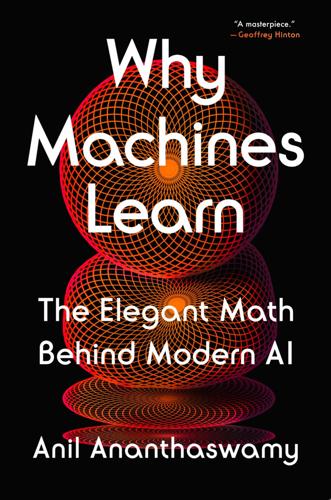
Why Machines Learn: The Elegant Math Behind Modern AI
by
Anil Ananthaswamy
Published 15 Jul 2024
NEURAL NETWORKS: THE REVIVAL BEGINS John Hopfield was among the few researchers who did not give up on neural networks, despite the blow dealt to the field by Marvin Minsky and Seymour Papert in their 1969 book, Perceptrons. (We’ll meet other researchers in subsequent chapters, in particular Geoff Hinton and Yann LeCun, who also kept the faith.) Recall that Frank Rosenblatt and others had shown, using the perceptron convergence theorem, that the perceptron will always find a linearly separating hyperplane if the dataset can be cleanly divided into two categories. Teaching the perceptron using training data involves finding the correct set of weights for the perceptron’s inputs.
…
This book presents the mathematics in the context of the social history. It is a masterpiece. The author is very good at explaining the mathematics in a way that makes it available to people with only a rudimentary knowledge of the field, but he is also a very good writer who brings the social history to life.” —GEOFFREY HINTON, deep learning pioneer, Turing Award winner, former VP at Google, and professor emeritus at the University of Toronto “After just a few minutes of reading Why Machines Learn, you’ll feel your own synaptic weights getting updated. By the end you will have achieved your own version of deep learning—with deep pleasure and insight along the way.”
…
Fortunately, the “intellectual discomfort” in store for us is eminently endurable and more than assuaged by the intellectual payoff, because underlying modern ML is some relatively simple and elegant math—a notion that’s best illustrated with an anecdote about Ilya Sutskever. Today, Sutskever is best known as the co-founder of OpenAI, the company behind ChatGPT. More than a decade ago, as a young undergraduate student looking for an academic advisor at the University of Toronto, Sutskever knocked on Geoffrey Hinton’s door. Hinton was already a well-known name in the field of “deep learning,” a form of machine learning, and Sutskever wanted to work with him. Hinton gave Sutskever some papers to read, which he devoured. He remembers being perplexed by the simplicity of the math, compared to the math and physics of his regular undergrad coursework.

Human Compatible: Artificial Intelligence and the Problem of Control
by
Stuart Russell
Published 7 Oct 2019
For the task of recognizing objects in photographs, deep learning algorithms have demonstrated remarkable performance. The first inkling of this came in the 2012 ImageNet competition, which provides training data consisting of 1.2 million labeled images in one thousand categories, and then requires the algorithm to label one hundred thousand new images.4 Geoff Hinton, a British computational psychologist who was at the forefront of the first neural network revolution in the 1980s, had been experimenting with a very large deep convolutional network: 650,000 nodes and 60 million parameters. He and his group at the University of Toronto achieved an ImageNet error rate of 15 percent, a dramatic improvement on the previous best of 26 percent.5 By 2015, dozens of teams were using deep learning methods and the error rate was down to 5 percent, comparable to that of a human who had spent weeks learning to recognize the thousand categories in the test.6 By 2017, the machine error rate was 2 percent.
…
Blog post on inceptionism research at Google: Alexander Mordvintsev, Christopher Olah, and Mike Tyka, “Inceptionism: Going deeper into neural networks,” Google AI Blog, June 17, 2015. The idea seems to have originated with J. P. Lewis, “Creation by refinement: A creativity paradigm for gradient descent learning networks,” in Proceedings of the IEEE International Conference on Neural Networks (IEEE, 1988). 8. News article on Geoff Hinton having second thoughts about deep networks: Steve LeVine, “Artificial intelligence pioneer says we need to start over,” Axios, September 15, 2017. 9. A catalog of shortcomings of deep learning: Gary Marcus, “Deep learning: A critical appraisal,” arXiv:1801.00631 (2018). 10. A popular textbook on deep learning, with a frank assessment of its weaknesses: François Chollet, Deep Learning with Python (Manning Publications, 2017). 11.
…
The Baldwin effect in evolution is usually attributed to the following paper: James Baldwin, “A new factor in evolution,” American Naturalist 30 (1896): 441–51. 8. The core idea of the Baldwin effect also appears in the following work: Conwy Lloyd Morgan, Habit and Instinct (Edward Arnold, 1896). 9. A modern analysis and computer implementation demonstrating the Baldwin effect: Geoffrey Hinton and Steven Nowlan, “How learning can guide evolution,” Complex Systems 1 (1987): 495–502. 10. Further elucidation of the Baldwin effect by a computer model that includes the evolution of the internal reward-signaling circuitry: David Ackley and Michael Littman, “Interactions between learning and evolution,” in Artificial Life II, ed.

The Optimist: Sam Altman, OpenAI, and the Race to Invent the Future
by
Keach Hagey
Published 19 May 2025
Both had been friends with Brockman and helped give him pointers when he embarked on his new career trajectory.16 Christiano, a fellow veteran of high school math competitions, was a doctoral student at Berkeley studying theoretical computer science. Altman had also cold-emailed someone whose talks on AI had blown him away when he looked them up online. Ilya Sutskever was already an icon in the world of AI with several breakthroughs under his belt, most notably the 2012 “AlexNet” paper that he co-authored with Alex Krizhevsky and Geoff Hinton, which had revived interest in neural networks. He went on to work at Google after the company bought their small neural networks startup. At Google he was doing groundbreaking research, including a recent paper presented at the previous December’s Conference on Neural Information Processing Systems—long abbreviated to NIPS before someone thought better of it and started calling it NeurIPS—on “sequence to sequence” learning, which forcefully articulated the first scaling paradigm that would soon become the engine of all recent AI progress.
…
When he was sixteen, his family immigrated to Canada, where he attended high school for one month as an eleventh grader before dropping out to attend the University of Toronto as a third-year college student. It took intense lobbying by Sutskever and his parents to get the university to accept him without a high school degree, but as soon as it did, he headed for the door of Geoff Hinton, the legendary AI researcher. He was seventeen, and while his main job was selling french fries at the nearby Paramount Wonderland amusement park, he asked if he could come study machine learning with him. It was a Sunday evening, and Hinton suggested Sutskever organize a time to come back for a real conversation.
…
They learned to code and used dynamic authoring tools like HyperCard, a pre-internet hypermedia system, for their homework. “The programs we built reminded me of toys—intuitive graphical toys that enabled us to convey ideas in delightful and profound ways,” McCauley said in an interview with the Chicago Toy & Game Group.27 The Vivarium program’s advisory council included such heavyweights as Geoff Hinton, Marvin Minsky, Douglas Adams (the author of The Hitchhiker’s Guide to the Galaxy), and Koko, the sign language–speaking gorilla. Kay remained a lifelong mentor to McCauley, whose professional life bore the hallmarks of his own devotion to pushing the frontiers of human-computer interfaces. (“The best way to predict the future is to invent it,” Kay famously said.)

The Alignment Problem: Machine Learning and Human Values
by
Brian Christian
Published 5 Oct 2020
By 1973, both the US and British governments have pulled their funding support for neural network research, and when a young English psychology student named Geoffrey Hinton declares that he wants to do his doctoral work on neural networks, again and again he is met with the same reply: “Minsky and Papert,” he is told, “have proved that these models were no good.”10 THE STORY OF ALEXNET It is 2012 in Toronto, and Alex Krizhevsky’s bedroom is too hot to sleep. His computer, attached to twin Nvidia GTX 580 GPUs, has been running day and night at its maximum thermal load, its fans pushing out hot exhaust, for two weeks. “It was very hot,” he says. “And it was loud.”11 He is teaching the machine how to see. Geoffrey Hinton, Krizhevsky’s mentor, is now 64 years old and has not given up.
…
But I am certain that, at a minimum, conversations and exchanges with the following people have made the book what it is: Pieter Abbeel, Rebecca Ackerman, Dave Ackley, Ross Exo Adams, Blaise Agüera y Arcas, Jacky Alciné, Dario Amodei, McKane Andrus, Julia Angwin, Stuart Armstrong, Gustaf Arrhenius, Amanda Askell, Mayank Bansal, Daniel Barcay, Solon Barocas, Renata Barreto, Andrew Barto, Basia Bartz, Marc Bellemare, Tolga Bolukbasi, Nick Bostrom, Malo Bourgon, Tim Brennan, Miles Brundage, Joanna Bryson, Krister Bykvist, Maya Çakmak, Ryan Carey, Joseph Carlsmith, Rich Caruana, Ruth Chang, Alexandra Chouldechova, Randy Christian, Paul Christiano, Jonathan Cohen, Catherine Collins, Sam Corbett-Davies, Meehan Crist, Andrew Critch, Fiery Cushman, Allan Dafoe, Raph D’Amico, Peter Dayan, Michael Dennis, Shiri Dori-Hacohen, Anca Drăgan, Eric Drexler, Rachit Dubey, Cynthia Dwork, Peter Eckersley, Joe Edelman, Owain Evans, Tom Everitt, Ed Felten, Daniel Filan, Jaime Fisac, Luciano Floridi, Carrick Flynn, Jeremy Freeman, Yarin Gal, Surya Ganguli, Scott Garrabrant, Vael Gates, Tom Gilbert, Adam Gleave, Paul Glimcher, Sharad Goel, Adam Goldstein, Ian Goodfellow, Bryce Goodman, Alison Gopnik, Samir Goswami, Hilary Greaves, Joshua Greene, Tom Griffiths, David Gunning, Gillian Hadfield, Dylan Hadfield-Menell, Moritz Hardt, Tristan Harris, David Heeger, Dan Hendrycks, Geoff Hinton, Matt Huebert, Tim Hwang, Geoffrey Irving, Adam Kalai, Henry Kaplan, Been Kim, Perri Klass, Jon Kleinberg, Caroline Knapp, Victoria Krakovna, Frances Kreimer, David Kreuger, Kaitlyn Krieger, Mike Krieger, Alexander Krizhevsky, Jacob Lagerros, Lily Lamboy, Lydia Laurenson, James Lee, Jan Leike, Ayden LeRoux, Karen Levy, Falk Lieder, Michael Littman, Tania Lombrozo, Will MacAskill, Scott Mauvais, Margaret McCarthy, Andrew Meltzoff, Smitha Milli, Martha Minow, Karthika Mohan, Adrien Morisot, Julia Mosquera, Sendhil Mullainathan, Elon Musk, Yael Niv, Brandie Nonnecke, Peter Norvig, Alexandr Notchenko, Chris Olah, Catherine Olsson, Toby Ord, Tim O’Reilly, Laurent Orseau, Pedro Ortega, Michael Page, Deepak Pathak, Alex Peysakhovich, Gualtiero Piccinini, Dean Pomerleau, James Portnow, Aza Raskin, Stéphane Ross, Cynthia Rudin, Jack Rusher, Stuart Russell, Anna Salamon, Anders Sandberg, Wolfram Schultz, Laura Schulz, Julie Shah, Rohin Shah, Max Shron, Carl Shulman, Satinder Singh, Holly Smith, Nate Soares, Daisy Stanton, Jacob Steinhardt, Jonathan Stray, Rachel Sussman, Jaan Tallinn, Milind Tambe, Sofi Thanhauser, Tena Thau, Jasjeet Thind, Travis Timmerman, Brian Tse, Alexander Matt Turner, Phebe Vayanos, Kerstin Vignard, Chris Wiggins, Cutter Wood, and Elana Zeide.
…
“We shall then pull our wheel chairs together, look at the tasteless cottage cheese in front of us, & recount the famous story of the conversation at the house of old GLAUCUS, where PROTAGORAS & the sophist HIPPIAS were staying: & try once more to penetrate their subtle & profound paradoxes about the knower & the known.” And then, in a trembling script, all caps: “BE THOU WELL.” 10. Geoff Hinton, “Lecture 2.2—Perceptrons: First-generation Neural Networks” (lecture), Neural Networks for Machine Learning, Coursera, 2012. 11. Alex Krizhevsky, personal interview, June 12, 2019. 12. The method for determining the gradient update in a deep network is known as “backpropagation”; it is essentially the chain rule from calculus, although it requires the use of differentiable neurons, not the all-or-nothing neurons considered by McCulloch, Pitts, and Rosenblatt.

These Strange New Minds: How AI Learned to Talk and What It Means
by
Christopher Summerfield
Published 11 Mar 2025
If d = 3, then each word is a position inside a 3D space (a cube) denoted by x, y, and z (AI researchers use the term ‘embeddings’ to describe these map-like representations in the network brain). Exactly the same principle holds if d = 50, except that the embedding space is much harder to visualize (pioneering AI researcher Geoff Hinton used to tell his students that to imagine a 13-dimensional space, they should think in 3D and just recite ‘thirteen, thirteen, thirteen’ to themselves). When the neural network was trained to use these feature-vector representations to predict the next word, it did so with much lower perplexity (i.e. more accurately) than equivalent n-gram models, which was a major step forward for language models based on neural networks.
…
They are already able to write witty limericks at the drop of a hat, solve reasoning puzzles that require you to think around corners, and write much better code than I can (admittedly, not too hard). But perhaps their most incredible facet is the universality of their knowledge. Already, each of the major LLMs knows more about the world than any one single human who has ever lived. This is quite an incredible statement, but undoubtedly true. As Geoffrey Hinton, the researcher with the best claim to have invented deep learning, dubbed the ‘Godfather of AI’ by the media, put it in May 2023: ‘I’ve come to the conclusion that the kind of intelligence we’re developing is very different from the intelligence we have […] so it’s as if you had 10,000 people and whenever one person learned something, everybody else automatically knew it.
…
And – more importantly – how will anyone over forty find anything left to talk about? It seems inevitable that there will be dramatic changes to the labour market, but exactly what will transpire requires a seriously high-end crystal ball. So far, our forecasts about the impacts of AI have been pretty wide of the mark. In 2016, Geoffrey Hinton – the first AI guru that we met on these pages – confidently predicted that we would soon stop training radiographers altogether, because AI systems could safely take over the screening of medical scans for scary-looking anomalies. That hasn’t happened yet, and is not imminent – presumably because these highly trained professionals do much more than just spotting dodgy blobs in the lungs.

The Inevitable: Understanding the 12 Technological Forces That Will Shape Our Future
by
Kevin Kelly
Published 6 Jun 2016
thousand games of chess: Personal correspondence with Daylen Yang (author of the Stockfish chess app), Stefan Meyer-Kahlen (developed the multiple award-winning computer chess program Shredder), and Danny Kopec (American chess International Master and cocreator of one of the standard computer chess testing systems), September 2014. “akin to building a rocket ship”: Caleb Garling, “Andrew Ng: Why ‘Deep Learning’ Is a Mandate for Humans, Not Just Machines,” Wired, May 5, 2015. In 2006, Geoff Hinton: Kate Allen, “How a Toronto Professor’s Research Revolutionized Artificial Intelligence,” Toronto Star, April 17, 2015. he dubbed “deep learning”: Yann LeCun, Yoshua Bengio, and Geoffrey Hinton, “Deep Learning,” Nature 521, no. 7553 (2015): 436–44. the network effect: Carl Shapiro and Hal R. Varian, Information Rules: A Strategic Guide to the Network Economy (Boston: Harvard Business Review Press, 1998).
…
The next level might group two eyes together and pass that meaningful chunk on to another level of hierarchical structure that associates it with the pattern of a nose. It can take many millions of these nodes (each one producing a calculation feeding others around it), stacked up to 15 levels high, to recognize a human face. In 2006, Geoff Hinton, then at the University of Toronto, made a key tweak to this method, which he dubbed “deep learning.” He was able to mathematically optimize results from each layer so that the learning accumulated faster as it proceeded up the stack of layers. Deep-learning algorithms accelerated enormously a few years later when they were ported to GPUs.

Exponential: How Accelerating Technology Is Leaving Us Behind and What to Do About It
by
Azeem Azhar
Published 6 Sep 2021
, Time, 7 February 1972 <http://content.time.com/time/subscriber/article/0,33009,905747,00.html> [accessed 3 April 2021]. 4 John Maynard Keynes, ‘Economic Possibilities for Our Grandchildren’, in Essays in Persuasion (London: Palgrave Macmillan UK, 2010), pp. 321–332 <https://doi.org/10.1007/978-1-349-59072-8_25>. 5 Creative Destruction Lab, ‘Geoff Hinton: On Radiology’, 24 November 2016 <https://www.youtube.com/watch?v=2HMPRXstSvQ> [accessed 24 February 2021]. 6 Paul Daugherty, H. James Wilson and Paul Michelman, ‘Revisiting the Jobs That Artificial Intelligence Will Create’, MIT Sloan Management Review (Summer 2017). 7 Lana Bandoim, ‘Robots Are Cleaning Grocery Store Floors During the Coronavirus Outbreak’, Forbes, 8 April 2020 <https://www.forbes.com/sites/lanabandoim/2020/04/08/robots-are-cleaning-grocery-store-floors-during-the-coronavirus-outbreak/> [accessed 24 February 2021]. 8 Jame DiBiasio, ‘A.I.
…
By 2010, Moore’s Law had resulted in enough power to facilitate a new kind of machine learning, ‘deep learning’, which involved creating layers of artificial neurons modelled on the cells that underpin human brains. These ‘neural networks’ had long been heralded as the next big thing in AI. Yet they had been stymied by a lack of computational power. Not any more, however. In 2012, a group of leading AI researchers – Alex Krizhevsky, Ilya Sutskever and Geoffrey Hinton – developed a ‘deep convolutional neural network’ which applied deep learning to the kinds of image-sorting tasks that AIs had long struggled with. It was rooted in extraordinary computing clout. The neural network contained 650,000 neurons and 60 million ‘parameters’, settings you could use to tune the system.
…
The rise of newly automated workplaces raises the prospect of mass redundancy. And it is framed as a more existential threat than Keynes’s fears of technological unemployment. Soon, we are told, we’ll reach a point where automated systems will render most of us unemployed and unemployable. In 2016, for example, Geoffrey Hinton – one of the AI pioneers we met earlier – publicly mused on the prospects of radiologists, the specialist doctors who deal with X-rays, computerised tomography and magnetic resonance imaging scans. Radiologists, Hinton told a small crowd of AI researchers and founders, were ‘like the coyote that’s already over the edge of the cliff, but hasn’t yet looked down, so doesn’t know there’s no ground underneath him.

Prediction Machines: The Simple Economics of Artificial Intelligence
by
Ajay Agrawal
,
Joshua Gans
and
Avi Goldfarb
Published 16 Apr 2018
Also, we thank our colleagues for discussions and feedback, including Nick Adams, Umair Akeel, Susan Athey, Naresh Bangia, Nick Beim, Dennis Bennie, James Bergstra, Dror Berman, Vincent Bérubé, Jim Bessen, Scott Bonham, Erik Brynjolfsson, Andy Burgess, Elizabeth Caley, Peter Carrescia, Iain Cockburn, Christian Catalini, James Cham, Nicolas Chapados, Tyson Clark, Paul Cubbon, Zavain Dar, Sally Daub, Dan Debow, Ron Dembo, Helene Desmarais, JP Dube, Candice Faktor, Haig Farris, Chen Fong, Ash Fontana, John Francis, April Franco, Suzanne Gildert, Anindya Ghose, Ron Glozman, Ben Goertzel, Shane Greenstein, Kanu Gulati, John Harris, Deepak Hegde, Rebecca Henderson, Geoff Hinton, Tim Hodgson, Michael Hyatt, Richard Hyatt, Ben Jones, Chad Jones, Steve Jurvetson, Satish Kanwar, Danny Kahneman, John Kelleher, Moe Kermani, Vinod Khosla, Karin Klein, Darrell Kopke, Johann Koss, Katya Kudashkina, Michael Kuhlmann, Tony Lacavera, Allen Lau, Eva Lau, Yann LeCun, Mara Lederman, Lisha Li, Ted Livingston, Jevon MacDonald, Rupam Mahmood, Chris Matys, Kristina McElheran, John McHale, Sanjog Misra, Matt Mitchell, Sanjay Mittal, Ash Munshi, Michael Murchison, Ken Nickerson, Olivia Norton, Alex Oettl, David Ossip, Barney Pell, Andrea Prat, Tomi Poutanen, Marzio Pozzuoli, Lally Rementilla, Geordie Rose, Maryanna Saenko, Russ Salakhutdinov, Reza Satchu, Michael Serbinis, Ashmeet Sidana, Micah Siegel, Dilip Soman, John Stackhouse, Scott Stern, Ted Sum, Rich Sutton, Steve Tadelis, Shahram Tafazoli, Graham Taylor, Florenta Teodoridis, Richard Titus, Dan Trefler, Catherine Tucker, William Tunstall-Pedoe, Stephan Uhrenbacher, Cliff van der Linden, Miguel Villas-Boas, Neil Wainwright, Boris Wertz, Dan Wilson, Peter Wittek, Alexander Wong, Shelley Zhuang, and Shivon Zilis.
…
Long term, however, Kindred is using a prediction machine trained on many observations of a human grasping via teleoperation to teach the robot to do that part itself. Should We Stop Training Radiologists? In October 2016, standing on stage in front of an audience of six hundred at our annual CDL conference on the business of machine intelligence, Geoffrey Hinton—a pioneer in deep learning neural networks—declared, “We should stop training radiologists now.” A key part of a radiologist’s job is to read images and detect the presence of irregularities that suggest medical problems. In Hinton’s view, AI would soon be better able to identify medically important objects in an image than any human.

Machines of Loving Grace: The Quest for Common Ground Between Humans and Robots
by
John Markoff
Published 24 Aug 2015
Finding only a small ministry of science laboratory and a professor who was working in a related field, LeCun obtained funding and laboratory space. His new professor told him, “I’ve no idea what you’re doing, but you seem like a smart guy so I’ll sign the papers.” But he didn’t stay long. First he went off to Geoff Hinton’s neural network group at the University of Toronto, and when the Bell Labs offer arrived he moved to New Jersey, continuing to refine his approach known as convolutional neural nets, initially focusing on the problem of recognizing handwritten characters for automated mail-sorting applications.
…
Interest in neural networks would not reemerge until 1978, with the work of Terry Sejnowski, a postdoctoral student in neurobiology at Harvard. Sejnowski had given up his early focus on physics and turned to neuroscience. After taking a summer course in Woods Hole, Massachusetts, he found himself captivated by the mystery of the brain. That year a British postdoctoral psychologist, Geoffrey Hinton, was studying at the University of California at San Diego under David Rumelhart. The older UC scientist had created the parallel-distributed processing group with Donald Norman, the founder of the cognitive psychology department at the school. Hinton, who was the great-great-grandson of logician George Boole, had come to the United States as a “refugee” as a direct consequence of the original AI Winter in England.
…
Known as the Neural Computation and Adaptive Perception project, it permitted him to handpick the most suitable researchers in the world across a range of fields stretching from neuroscience to electrical engineering. It helped crystallize a community of people interested in the neural network research. Terry Sejnowski, Yann LeCun, and Geoffrey Hinton (from left to right), three scientists who helped revive artificial intelligence by developing biologically inspired neural network algorithms. (Photo courtesy of Yann LeCun) This time they had something else going for them—the pace of computing power had accelerated, making it possible to build neural networks of vast scale, processing data sets orders of magnitude larger than before.
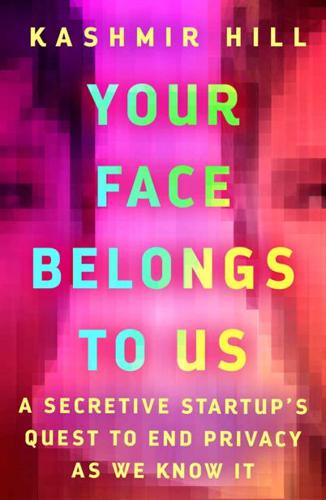
Your Face Belongs to Us: A Secretive Startup's Quest to End Privacy as We Know It
by
Kashmir Hill
Published 19 Sep 2023
Ton-That got the OpenFace code up and running, but it wasn’t perfect, so he kept searching, wandering through the academic literature and code repositories, trying out this and that. He was like a person walking through an orchard, sampling the fruit of decades of research, ripe for the picking and gloriously free. “I couldn’t have figured it all out from scratch, but these other guys, like Geoff Hinton, they stuck with it and it was like a snowball,” he said. “There was a lot of stuff we could mine.” When Ton-That didn’t understand something he read in an academic paper, he wasn’t afraid to exercise his curiosity. He would go to the professors’ websites, find their phone numbers, and call them up to ask questions.
…
Ever since then, a small group of neural network believers had toiled away in spite of Minsky, convinced that he was wrong and that the biggest breakthroughs in the field would come from programs that could teach themselves through trial and error. Most AI researchers thought the neural network researchers were delusional, but those technologists, who included university professors with nerd-famous names such as Yann LeCun and Geoffrey Hinton, were determined. They kept tinkering with their neural networks, going to conferences and publishing papers about their work, in the hope of recruiting others to their technological cause. And eventually, thanks to faster computers, new techniques, and loads more data, their neural networks started to work.
…
GO TO NOTE REFERENCE IN TEXT “Let’s go to one million”: Mark Zuckerberg’s response as recalled by Yaniv Taigman in ibid. GO TO NOTE REFERENCE IN TEXT “No way”: Yaniv Taigman’s recollection of the conversation in ibid. GO TO NOTE REFERENCE IN TEXT blew the competition: The SuperVision developers were Geoffrey Hinton and his two graduate students, Ilya Sutskever and Alex Krizhevsky. For more on this, see Cade Metz, Genius Makers: The Mavericks Who Brought AI to Google, Facebook, and the World (New York: Dutton, 2021). GO TO NOTE REFERENCE IN TEXT Taigman realized: Author’s interview with Yaniv Taigman, 2021.

Artificial Intelligence: A Modern Approach
by
Stuart Russell
and
Peter Norvig
Published 14 Jul 2019
These so-called connectionist models were seen by some as direct competitors both to the symbolic models promoted by Newell and Simon and to the logicist approach of McCarthy and others. It might seem obvious that at some level humans manipulate symbols—in fact, the anthropologist Terrence Deacon’s book The Symbolic Species (1997) suggests that this is the defining characteristic of humans. Against this, Geoff Hinton, a leading figure in the resurgence of neural networks in the 1980s and 2010s, has described symbols as the “luminiferous aether of AI”—a reference to the non-existent medium through which many 19th-century physicists believed that electromagnetic waves propagated. Certainly, many concepts that we name in language fail, on closer inspection, to have the kind of logically defined necessary and sufficient conditions that early AI researchers hoped to capture in axiomatic form.
…
The back-propagation algorithm was discovered independently several times in different contexts (Kelley, 1960; Bryson, 1962; Dreyfus, 1962; Bryson and Ho, 1969; Werbos, 1974; Parker, 1985) and Stuart Dreyfus (1990) calls it the “Kelley–Bryson gradient procedure.” Although Werbos had applied it to neural networks, this idea did not become widely known until a paper by David Rumelhart, Geoff Hinton, and Ron Williams (1986) appeared in Nature giving a nonmathematical presentation of the algorithm. Mathematical respectability was enhanced by papers showing that multilayer feedforward networks are (subject to technical conditions) universal function approximators (Cybenko, 1988, 1989). The late 1980s and early 1990s saw a huge growth in neural network research: the number of papers mushroomed by a factor of 200 between 1980–84 and 1990–94.
…
The late 1980s and early 1990s saw a huge growth in neural network research: the number of papers mushroomed by a factor of 200 between 1980–84 and 1990–94. In the late 1990s and early 2000s, interest in neural networks waned as other techniques such as Bayes nets, ensemble methods, and kernel machines came to the fore. Interest in deep models was sparked when Geoff Hinton’s research on deep Bayesian networks–—generative models with category variables at the root and evidence variables at the leaves—began to bear fruit, outperforming kernel machines on small benchmark data sets (Hinton et al., 2006). Interest in deep learning exploded when Krizhevsky et al. (2013) used deep convolutional networks to win the ImageNet competition (Russakovsky et al., 2015).

The Master Algorithm: How the Quest for the Ultimate Learning Machine Will Remake Our World
by
Pedro Domingos
Published 21 Sep 2015
Another big issue that Hopfield’s model ignored is that real neurons are statistical: they don’t deterministically turn on and off as a function of their inputs; rather, as the weighted sum of inputs increases, the neuron becomes more likely to fire, but it’s not certain that it will. In 1985, David Ackley, Geoff Hinton, and Terry Sejnowski replaced the deterministic neurons in Hopfield networks with probabilistic ones. A neural network now had a probability distribution over its states, with higher-energy states being exponentially less likely than lower-energy ones. In fact, the probability of finding the network in a particular state was given by the well-known Boltzmann distribution from thermodynamics, so they called their network a Boltzmann machine.
…
If two neurons tend to fire together during the day but less so while asleep, the weight of their connection goes up; if it’s the opposite, they go down. By doing this day after day, the predicted correlations between sensory neurons evolve until they match the real ones. At this point, the Boltzmann machine has learned a good model of the data and effectively solved the credit-assignment problem. Geoff Hinton went on to try many variations on Boltzmann machines over the following decades. Hinton, a psychologist turned computer scientist and great-great-grandson of George Boole, the inventor of the logical calculus used in all digital computers, is the world’s leading connectionist. He has tried longer and harder to understand how the brain works than anyone else.
…
A linear brain, no matter how large, is dumber than a roundworm. S curves are a nice halfway house between the dumbness of linear functions and the hardness of step functions. The perceptron’s revenge Backprop was invented in 1986 by David Rumelhart, a psychologist at the University of California, San Diego, with the help of Geoff Hinton and Ronald Williams. Among other things, they showed that backprop can learn XOR, enabling connectionists to thumb their noses at Minsky and Papert. Recall the Nike example: young men and middle-aged women are the most likely buyers of Nike shoes. We can represent this with a network of three neurons: one that fires when it sees a young male, another that fires when it sees a middle-aged female, and another that fires when either of those does.

Surviving AI: The Promise and Peril of Artificial Intelligence
by
Calum Chace
Published 28 Jul 2015
Most famously, it paid $500m in January 2014 for DeepMind, a two year-old company employing just 75 people which builds AIs that can learn to play video games better than people. Later in the year it paid another eight-figure sum to hire the seven academics who had established Dark Blue Labs and Vision Factory, two more AI start-ups based in the UK. Before that, in March 2013, it had hired Geoff Hinton, one of the pioneers of machine learning, based in Toronto. All this activity is partly a matter of economic ambition, but it goes wider than that. Google’s founders and leaders want the company to be financially successful, but they also want it to make a difference to people’s lives. Founders Larry Page and Sergei Brin think the future will be a better place for humans than the present, and they are impatient for it to arrive.
…
The first experiments with ANNs were made in the 1950s, and Frank Rosenblatt used them to construct the Mark I Perceptron, the first computer which could learn new skills by trial and error. Early hopes for the quick development of thinking machines were dashed, however, and neural nets fell into disuse until the late 1980s, when they experienced a renaissance along with what came to be known as deep learning thanks to pioneers Yann LeCun (now at Facebook), Geoff Hinton (now at Google) and Yoshua Bengio, a professor at the University of Montreal. Yann LeCun describes deep learning as follows. “A pattern recognition system is like a black box with a camera at one end, a green light and a red light on top, and a whole bunch of knobs on the front. The learning algorithm tries to adjust the knobs so that when, say, a dog is in front of the camera, the red light turns on, and when a car is put in front of the camera, the green light turns on.
…
We are able to learn about categories of items at a higher level of abstraction. AGI optimists think that we will work out how to do that with computers too. There are plenty of serious AI researchers who do believe that the probabilistic techniques of machine learning will lead to AGI within a few decades rather than centuries. The veteran AI researcher Geoff Hinton, now working at Google, forecast in May 2015 that the first machine with common sense could be developed in ten years. (34) Part of the reason for the difference of opinion may be that the latter group take very seriously the notion that exponential progress in computing capability will speed progress towards the creation of an AGI.
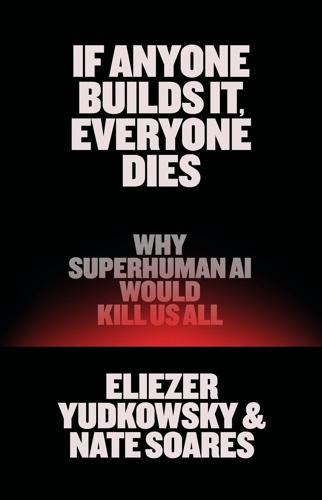
If Anyone Builds It, Everyone Dies: Why Superhuman AI Would Kill Us All
by
Eliezer Yudkowsky
and
Nate Soares
Published 15 Sep 2025
Even crewed flights have a historical failure rate above 1 percent (about 0.79 percent in the last couple of decades). 10. 10 to 20 percent: Mark Doman and Benjamin Sveen, “AI’s Dark In-joke,” ABC News, July 14, 2023, abc.net.au; METR (Model Evaluation & Threat Research), “Q&A with Geoffrey Hinton,” June 27, 2024, 38:07, youtube.com. In the Q&A, Hinton seems to have been misinformed about Yudkowsky’s confidence in disaster, citing it as 99.999 percent. While we authors think that disaster is a strong default outcome, five nines is a ridiculous level of confidence that neither of us endorse. 11. even odds: Doman and Sveen, “AI’s Dark In-joke.” 12. out of modesty: METR, “Q&A with Geoffrey Hinton,” 38:07. 13. fired or resigned: “Nearly Half of OpenAI’s AGI Safety Researchers Resign Amid Growing Focus on Commercial Product Development,” Benzinga, August 28, 2024, benzinga.com; Sharon Goldman, “Exodus at OpenAI: Nearly half of AGI Safety Staffers Have Left, Says Former Researcher,” Fortune, August 28, 2024, fortune.com; Shakeel Hashim, “OpenAI Employee Says He Was Fired for Raising Security Concerns to Board,” Transformer (blog), June 4, 2024, transformernews.ai; Rachel Metz and Shirin Ghaffary, “OpenAI Dissolves High-Profile Safety Team after Chief Scientist Sutskever’s Exit,” Bloomberg, May 17, 2024, bloomberg.com; Sigal Samuel, “‘I Lost Trust’: Why the OpenAI Team in Charge of Safeguarding Humanity Imploded,” Vox, May 18, 2024, vox.com.
…
INTRODUCTION HARD CALLS AND EASY CALLS “MITIGATING THE RISK OF EXTINCTION FROM AI SHOULD BE A global priority alongside other societal-scale risks such as pandemics and nuclear war.” In early 2023, hundreds of Artificial Intelligence scientists signed an open letter consisting of that one sentence. These signatories included some of the most decorated researchers in the field. Among them were Nobel laureate Geoffrey Hinton and Yoshua Bengio, who shared the Turing Award for inventing deep learning. We—Eliezer Yudkowsky and Nate Soares—also signed the letter, though we considered it a severe understatement. It wasn’t the AIs of 2023 that worried us or the other signatories. Nor are we worried about the AIs that exist as we write this, in early 2025.
…
IfAnyoneBuildsIt.com/2 Footnotes i Finding architectures that make these gradients behave nicely even for parameters that are very “deep” in the process—very far from the output—is the sort of thing that people in the field of AI win awards for. And, very roughly speaking, this is what Geoffrey Hinton and John Hopfield won their Nobel prize for. ii Roughly speaking, they figured this out by observing that the “attention heads”—collections of weights used to associate the current token with previous tokens to determine how they affect the next prediction—associate the “.” token with tokens from all over the sentence, whereas attention heads for other tokens tend to associate their token mostly with the tokens next to it.

The Road to Conscious Machines
by
Michael Wooldridge
Published 2 Nov 2018
A neuron in a state-of-the-art neural network at the time of writing would have about as many connections as there are in a cat brain; a human neuron has on average about 10,000. So, deep neural networks have more layers, and more, better-connected neurons. To train such networks, techniques beyond backprop were needed, and these were provided in 2006 by Geoff Hinton, a British-Canadian researcher who, more than anyone else, is identified with the deep learning movement. Hinton is, by any reckoning, a remarkable individual. He was one of the leaders of the PDP movement in the 1980s, and one of the inventors of backprop. What I find personally so remarkable is that Hinton didn’t lose heart when PDP research began to lose favour.
…
If you look at the ‘frisbee’ category, then you’ll see that really the only thing they feature in common is, well, frisbees. In some images, of course, the frisbees are being thrown from one person to another, but in some, the frisbee is on a table, with nobody in view. They are all different – except that they all feature frisbees. The eureka moment for image classification came in 2012, when Geoff Hinton and two colleagues, Alex Krizhevsky and Ilya Sutskever, demonstrated a system called AlexNet, a neural net that dramatically improved performance in an international image recognition competition.10 The final ingredient required to make deep learning work was raw computer-processing power. Training a deep neural net requires a huge amount of computer-processing time.
…
In the remainder of this chapter, I want to look in more detail at two of the most prominent opportunities for AI: the first is the use of AI in healthcare; the second is the long-held dream of driverless cars. AI-Powered Healthcare People should stop training radiologists now. It is just completely obvious that within five years deep learning is going to do better than radiologists. –– Geoff Hinton (2016) Cardiogram is building your personal healthcare assistant. We want to turn your wearable device into a continuous health monitor that can be used to not only track sleep and fitness, but one day may also prevent a stroke and save your life. –– Cardiogram company website4 Anybody with even the vaguest interest in politics and economics will recognize that the provision of healthcare is one of the most important global financial problems for private citizens and for governments.
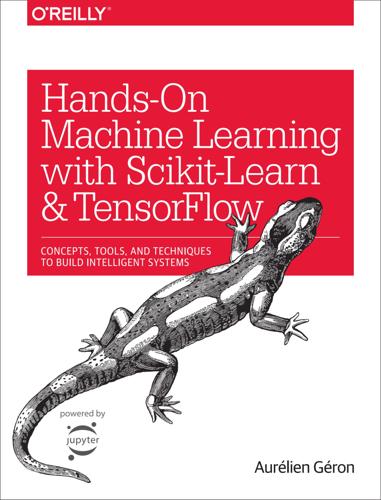
Hands-On Machine Learning With Scikit-Learn and TensorFlow: Concepts, Tools, and Techniques to Build Intelligent Systems
by
Aurélien Géron
Published 13 Mar 2017
Polyak (1964). 12 “A Method for Unconstrained Convex Minimization Problem with the Rate of Convergence O(1/k2 ),” Yurii Nesterov (1983). 13 “Adaptive Subgradient Methods for Online Learning and Stochastic Optimization,” J. Duchi et al. (2011). 14 This algorithm was created by Tijmen Tieleman and Geoffrey Hinton in 2012, and presented by Geoffrey Hinton in his Coursera class on neural networks (slides: http://goo.gl/RsQeis; video: https://goo.gl/XUbIyJ). Amusingly, since the authors have not written a paper to describe it, researchers often cite “slide 29 in lecture 6” in their papers. 15 “Adam: A Method for Stochastic Optimization,” D.
…
If any code samples or other technology this work contains or describes is subject to open source licenses or the intellectual property rights of others, it is your responsibility to ensure that your use thereof complies with such licenses and/or rights. 978-1-491-96229-9 [LSI] Preface The Machine Learning Tsunami In 2006, Geoffrey Hinton et al. published a paper1 showing how to train a deep neural network capable of recognizing handwritten digits with state-of-the-art precision (>98%). They branded this technique “Deep Learning.” Training a deep neural net was widely considered impossible at the time,2 and most researchers had abandoned the idea since the 1990s.
…
Deep Learning is best suited for complex problems such as image recognition, speech recognition, or natural language processing, provided you have enough data, computing power, and patience. Other Resources Many resources are available to learn about Machine Learning. Andrew Ng’s ML course on Coursera and Geoffrey Hinton’s course on neural networks and Deep Learning are amazing, although they both require a significant time investment (think months). There are also many interesting websites about Machine Learning, including of course Scikit-Learn’s exceptional User Guide. You may also enjoy Dataquest, which provides very nice interactive tutorials, and ML blogs such as those listed on Quora.

AI Superpowers: China, Silicon Valley, and the New World Order
by
Kai-Fu Lee
Published 14 Sep 2018
But the networks themselves were still severely limited in what they could do. Accurate results to complex problems required many layers of artificial neurons, but researchers hadn’t found a way to efficiently train those layers as they were added. Deep learning’s big technical break finally arrived in the mid-2000s, when leading researcher Geoffrey Hinton discovered a way to efficiently train those new layers in neural networks. The result was like giving steroids to the old neural networks, multiplying their power to perform tasks such as speech and object recognition. Soon, these juiced-up neural networks—now rebranded as “deep learning”—could outperform older models at a variety of tasks.
…
People are so excited about deep learning precisely because its core power—its ability to recognize a pattern, optimize for a specific outcome, make a decision—can be applied to so many different kinds of everyday problems. That’s why companies like Google and Facebook have scrambled to snap up the small core of deep-learning experts, paying them millions of dollars to pursue ambitious research projects. In 2013, Google acquired the startup founded by Geoffrey Hinton, and the following year scooped up British AI startup DeepMind—the company that went on to build AlphaGo—for over $500 million. The results of these projects have continued to awe observers and grab headlines. They’ve shifted the cultural zeitgeist and given us a sense that we stand at the precipice of a new era, one in which machines will radically empower and/or violently displace human beings.
…
That’s a process that requires well-trained AI scientists, the tinkerers of this age. Today, those tinkerers are putting AI’s superhuman powers of pattern recognition to use making loans, driving cars, translating text, playing Go, and powering your Amazon Alexa. Deep-learning pioneers like Geoffrey Hinton, Yann LeCun, and Yoshua Bengio—the Enrico Fermis of AI—continue to push the boundaries of artificial intelligence. And they may yet produce another game-changing breakthrough, one that scrambles the global technological pecking order. But in the meantime, the real action today is with the tinkerers.

The Thinking Machine: Jensen Huang, Nvidia, and the World's Most Coveted Microchip
by
Stephen Witt
Published 8 Apr 2025
Meanwhile, throughout the 1970s and 1980s a coterie of renegade computer scientists continued to pursue research on neural nets, believing that the rickety machinery of yore might be re-created with software and that multiple layers of neurons might overcome limitations that a single layer could not. Most AI researchers regarded these mavericks as misguided, or possibly insane, but in 1986 cognitive psychologist David Rumelhart, working with computer scientists Geoffrey Hinton and Ronald Williams at UC–San Diego, published an elegant mathematical procedure for training multilayer neural nets called “backpropagation.”[*] The method allowed researchers to fine-tune the computer’s artificial neurons in response to new information, in the same way that the human brain formed new synaptic connections when a task was learned.
…
Eleven AlexNet If Alex Krizhevsky could have turned himself invisible, he probably would have. The talented computer programmer had an almost pathological aversion to attention. He was a small man and a slight one, with pale skin and ruddy orange hair. He revealed few details about his private life to colleagues, even to some who had known him for years. Geoffrey Hinton, his PhD adviser, could tell me little about him, save one important detail: “Alex was probably the best programmer I ever met.” Hinton first met Krizhevsky in the late 2000s, when he was a graduate student living at home with his parents and attending the University of Toronto. Krizhevsky had been born to a Jewish family in the Soviet Union, in what is today the imperiled territory of eastern Ukraine.
…
“After a young researcher challenged Musk’s decision, suggesting it would exacerbate the AI arms race, he called the researcher a ‘jackass’ and stormed out of the building,” The Wall Street Journal reported. Ilya Sutskever remained. The AlexNet coauthor had continued to publish important research and now rivaled his mentor Geoffrey Hinton as one of the most cited scholars in the field. Sutskever focused on AI to the exclusion of everything else, including, increasingly, grooming: his beard was tangled and unkempt, his eyebrows were thick and untrimmed, and you could see most of his scalp through his thinning, wispy hair. His strength, as Hinton had observed, was the speed with which he could pivot toward a good idea.

The Big Nine: How the Tech Titans and Their Thinking Machines Could Warp Humanity
by
Amy Webb
Published 5 Mar 2019
In all of these cases, the computers would make incomprehensible moves, or they’d play too aggressively, or they’d miscalculate their opponent’s posture. Sometime in the middle of all that work were a handful of researchers who, once again, were workshopping neural networks, an idea championed by Marvin Minsky and Frank Rosenblatt during the initial Dartmouth meeting. Cognitive scientist Geoff Hinton and computer scientists Yann Lecun and Yoshua Bengio each believed that neural net–based systems would not only have serious practical applications—like automatic fraud detection for credit cards and automatic optical character recognition for reading documents and checks—but that it would become the basis for what artificial intelligence would become.
…
This tribe of groundbreaking, brilliant comics laid the foundation for the future of American entertainment.14 Collectively, this group of men still wields influence today. In a way, AI went through a similar radical transformation because of a modern-day tribe that shared the same values, ideas, and goals. Those three deep-learning pioneers discussed earlier—Geoff Hinton, Yann Lecun, and Yoshua Bengio—were the Sam Kinisons and Richard Pryors of the AI world in the early days of deep neural nets. Lecun studied under Hinton at the University of Toronto where the Canadian Institute for Advanced Research (CIFAR) inculcated a small group of researchers, which included Yoshua Bengio.
…
But the white man is currently serving an eight-year prison term for yet another crime—breaking into a warehouse and stealing thousands of dollars’ worth of electronics.16 ProPublica looked at the risk scores assigned to more than 7,000 people arrested in Florida to see whether this was an anomaly—and again, they found significant bias encoded within the algorithms, which were twice as likely to incorrectly flag Black defendants as future criminals while mislabeling white defendants as low risk. The optimization effect sometimes causes brilliant AI tribes to make dumb decisions. Recall DeepMind, which built the AlphaGo and AlphaGo Zero systems and stunned the AI community as it dominated grandmaster Go matches. Before Google acquired the company, it sent Geoff Hinton (the University of Toronto professor who was on leave working on deep learning there) and Jeff Dean, who was in charge of Google Brain, to London on a private jet to meet its supernetwork of top PhDs in AI. Impressed with the technology and DeepMind’s remarkable team, they recommended that Google make an acquisition.

Artificial Intelligence: A Guide for Thinking Humans
by
Melanie Mitchell
Published 14 Oct 2019
In the next chapter, I’ll recount the extraordinary ascent of ConvNets from relative obscurity to near-complete dominance in machine vision, a transformation made possible by a concurrent technological revolution: that of “big data.” 5 ConvNets and ImageNet Yann LeCun, the inventor of ConvNets, has worked on neural networks all of his professional life, starting in the 1980s and continuing through the winters and springs of the field. As a graduate student and postdoctoral fellow, he was fascinated by Rosenblatt’s perceptrons and Fukushima’s neocognitron, but noted that the latter lacked a good supervised-learning algorithm. Along with other researchers (most notably, his postdoctoral advisor Geoffrey Hinton), LeCun helped develop such a learning method—essentially the same form of back-propagation used on ConvNets today.1 In the 1980s and ’90s, while working at Bell Labs, LeCun turned to the problem of recognizing handwritten digits and letters. He combined ideas from the neocognitron with the back-propagation algorithm to create the semi-eponymous “LeNet”—one of the earliest ConvNets.
…
LeNet and its successor ConvNets did not do well in scaling up to more complex vision tasks. By the mid-1990s, neural networks started falling out of favor in the AI community, and other methods came to dominate the field. But LeCun, still a believer, kept working on ConvNets, gradually improving them. As Geoffrey Hinton later said of LeCun, “He kind of carried the torch through the dark ages.”2 LeCun, Hinton, and other neural network loyalists believed that improved, larger versions of ConvNets and other deep networks would conquer computer vision if only they could be trained with enough data. Stubbornly, they kept working on the sidelines throughout the 2000s.
…
What’s more, the winning entry did not use support vector machines or any of the other dominant computer-vision methods of the day. Instead, it was a convolutional neural network. This particular ConvNet has come to be known as AlexNet, named after its main creator, Alex Krizhevsky, then a graduate student at the University of Toronto, supervised by the eminent neural network researcher Geoffrey Hinton. Krizhevsky, working with Hinton and a fellow student, Ilya Sutskever, created a scaled-up version of Yann LeCun’s LeNet from the 1990s; training such a large network was now made possible by increases in computer power. AlexNet had eight layers, with about sixty million weights whose values were learned via back-propagation from the million-plus training images.7 The Toronto group came up with some clever methods for making the network training work better, and it took a cluster of powerful computers about a week to train AlexNet.

System Error: Where Big Tech Went Wrong and How We Can Reboot
by
Rob Reich
,
Mehran Sahami
and
Jeremy M. Weinstein
Published 6 Sep 2021
“artificial intelligence (AI) system”: Scott Mayer McKinney et al., “International Evaluation of an AI System for Breast Cancer Screening,” Nature 577 (January 2020): 89–94, https://doi.org/10.1038/s41586-019-1799-6. “an algorithm that can detect”: Pranav Rajpurkar et al., “Radiologist-Level Pneumonia Detection on Chest X-Rays with Deep Learning,” CheXNet, December 25, 2017, http://arxiv.org/abs/1711.05225. “people should stop training radiologists”: Geoff Hinton, “Geoff Hinton: On Radiology,” Creative Destruction Lab, uploaded to YouTube November 24, 2016, https://www.youtube.com/watch?v=2HMPRXstSvQ. the work radiologists and other medical professionals do: Hugh Harvey, “Why AI Will Not Replace Radiologists,” Medium, April 7, 2018, https://towardsdatascience.com/why-ai-will-not-replace-radiologists-c7736f2c7d80.
…
They noted, “In an independent study of six radiologists, the AI system outperformed all of the human [mammogram] readers.” Similarly, a team from Stanford developed “an algorithm that can detect pneumonia from chest X-rays at a level exceeding practicing radiologists.” Developments such as these led Geoff Hinton, a pioneer in neural networks and deep learning and a winner of the 2018 A. M. Turing Award, to state that “people should stop training radiologists now. It’s just completely obvious that within five years deep learning is going to do better than radiologists.” That was in 2016. Since that time, it has been noted that the work radiologists and other medical professionals do is much broader than just interpreting X-rays.

The Great Wave: The Era of Radical Disruption and the Rise of the Outsider
by
Michiko Kakutani
Published 20 Feb 2024
The Bad News Is It’s Not for Us’: Why the Godfather of AI Fears for Humanity,” The Guardian, May 5, 2023, theguardian.com/technology/2023/may/05/geoffrey-hinton-godfather-of-ai-fears-for-humanity. GO TO NOTE REFERENCE IN TEXT “If there’s any way”: Manuel G. Pascual, “Geoffrey Hinton: ‘We Need to Find a Way to Control Artificial Intelligence Before It’s Too Late,’ ” El País, May 12, 2023, english.elpais.com/science-tech/2023-05-12/geoffrey-hinton-we-need-to-find-a-way-to-control-artificial-intelligence-before-its-too-late.html. GO TO NOTE REFERENCE IN TEXT “annotated for scientists, engineers”: Mary Shelley, Frankenstein (Cambridge, Mass.: MIT Press, 2017).
…
But it’s clear that the race by Microsoft, Google, and other Silicon Valley companies to capitalize on AI will mean that many of these systems will be released without adequate guardrails and without a full understanding of AI’s terrifying and still emerging abilities. In the spring of 2023, Geoffrey Hinton—the computer scientist often called “the godfather of AI”—left Google to warn the public of the perils of artificial intelligence. Startled by the rapid advances made by ChatGPT, he said he now believes that AI will surpass humans in intelligence in five to twenty years, possibly even in one or two, and that it will be smarter than people by the same measure that “we’re more intelligent than a frog.”

The Economic Singularity: Artificial Intelligence and the Death of Capitalism
by
Calum Chace
Published 17 Jul 2016
This became known as symbolic AI, or Good Old-Fashioned AI (GOFAI). Machine learning, by contrast, is the process of creating and refining algorithms which can produce conclusions based on data without being explicitly programmed to do so. The turning point came in 2012 when researchers in Toronto led by Geoff Hinton won an AI image recognition competition called ImageNet.[lxiv] Hinton is a British researcher now at Toronto University and Google, and perhaps the most important figure behind the rise of deep learning as the most powerful of today's AI techniques. (The word algorithm comes from the name of a 9th-century Persian mathematician, Al-Khwarizmi.
…
Even the worst case predictions envisage continued rapid improvement in computer processing power, albeit perhaps slower than previously. In December 2015, Microsoft's chief speech scientist Xuedong Huang noted that speech recognition has improved 20% a year consistently for the last 20 years. He predicted that computers would be as good as humans at understanding human speech within five years. Geoff Hinton – the man whose team won the landmark 2012 ImageNet competition – went further. In May 2015 he said that he expects machines to demonstrate common sense within a decade. Common sense can be described as having a mental model of the world which allows you to predict what will happen if certain actions are taken.

Supremacy: AI, ChatGPT, and the Race That Will Change the World
by
Parmy Olson
Many of the company’s staff were experts in deep learning, which for years had seemed like a backwater in the field until just recently. The turning point had come in 2012. A Stanford AI professor named Fei-Fei Li had created an annual challenge for academics called ImageNet, to which researchers submitted AI models that tried to visually recognize images of cats, furniture, cars, and more. That year, scientist Geoffrey Hinton’s team of researchers used deep learning to create a model that was far more accurate than anything before, and their results stunned the AI field. Suddenly everybody wanted to hire experts in this deep-learning AI theory inspired by how the brain recognized patterns. It was a tiny field with just a few dozen experts, says Legg.
…
The group talked more about building an AI lab that would be completely free from corporate pressures and that would “open-source” its research, effectively giving it away for free, and how that would stop Big Tech firms like Google and Facebook from having a stranglehold on AI as it became more powerful. Nearly all of the scientists agreed to come on board, including Sutskever, the talented scientist who rarely seemed to smile. Having grown up in Russia and Israel and having worked with prestigious deep-learning pioneer Geoffrey Hinton, he would now be ditching Google Brain for OpenAI. With about a dozen people on board, the team headed to Montreal, Canada, for an annual AI conference called NIPS (now called NeurIPS) in December 2015, to announce the new research lab. Snow was building up outside the venue as members of the team talked to other conference participants about their new lab.
…
For all the talent and resources the company had, its bloat and fear of disrupting its ad business hampered staff who tried to push through new innovations. Google Brain had the company’s most advanced deep-learning researchers, but they grappled with unclear goals and strategies from management, former staff there say. The culture of complacency partly came from having so many talented scientists on staff, like Geoffrey Hinton. The bar was high, and Google was already using cutting-edge AI techniques, like recurrent neural networks, to process billions of words of text every day. If you were a young AI researcher like Illia Polosukhin, you were sitting next to the people who’d invented these techniques. In early 2017, Polosukhin was getting ready to leave Google and was willing to take some risks.

Possible Minds: Twenty-Five Ways of Looking at AI
by
John Brockman
Published 19 Feb 2019
Within a few years, Judea’s Bayesian networks had completely overshadowed the previous rule-based approaches to artificial intelligence. The advent of deep learning—in which computers, in effect, teach themselves to be smarter by observing tons of data—has given him pause, because this method lacks transparency. While recognizing the impressive achievements in deep learning by colleagues such as Michael I. Jordan and Geoffrey Hinton, he feels uncomfortable with this kind of opacity. He set out to understand the theoretical limitations of deep-learning systems and points out that basic barriers exist that will prevent them from achieving a human kind of intelligence, no matter what we do. Leveraging the computational benefits of Bayesian networks, Judea realized that the combination of simple graphical models and data could also be used to represent and infer cause-effect relationships.
…
Another strong incentive to turn a blind eye to the AI risk is the (very human) curiosity that knows no bounds. “When you see something that is technically sweet, you go ahead and do it and you argue about what to do about it only after you have had your technical success. That is the way it was with the atomic bomb,” said J. Robert Oppenheimer. His words were echoed recently by Geoffrey Hinton, arguably the inventor of deep learning, in the context of AI risk: “I could give you the usual arguments, but the truth is that the prospect of discovery is too sweet.” Undeniably, we have both entrepreneurial attitude and scientific curiosity to thank for almost all the nice things we take for granted in the modern era.
…
We tend to underestimate the complexity and creativity of the human brain and how amazingly general it is. If AI is to become more humanlike in its abilities, the machine-learning and neuroscience communities need to interact closely, something that is happening already. Some of today’s greatest exponents of machine learning—such as Geoffrey Hinton, Zoubin Ghahramani, and Demis Hassabis—have backgrounds in cognitive neuroscience, and their success has been at least in part due to attempts to model brainlike behavior in their algorithms. At the same time, neurobiology has also flourished. All sorts of tools have been developed to watch which neurons are firing and genetically manipulate them and see what’s happening in real time with inputs.

Life After Google: The Fall of Big Data and the Rise of the Blockchain Economy
by
George Gilder
Published 16 Jul 2018
Google, meanwhile, under its new CEO, Sundar Pichai, pivoted away from its highly publicized “mobile first” mantra, which had led to its acquisitions of Android and Ad Mob, and toward “AI first.” Google was the recognized intellectual leader of the industry, and its AI ostentation was widely acclaimed. Indeed it signed up most of the world’s AI celebrities, including its spearheads of “deep learning” prowess, from Geoffrey Hinton and Andrew Ng to Jeff Dean, the beleaguered Anthony Levandowski, and Demis Hassabis of DeepMind. If Google had been a university, it would have utterly outshone all others in AI talent. It must have been discouraging, then, to find that Amazon had shrewdly captured much of the market for AI services with its 2014 Alexa and Echo projects.
…
The most prominent participants were the bright lights of Google: Larry Page, Eric Schmidt, Ray Kurzweil, Demis Hassabis, and Peter Norvig, along with former Googler Andrew Ng, later of Baidu and Stanford. Also there was Facebook’s Yann LeCun, an innovator in deep-learning math and a protégé of Google’s Geoffrey Hinton. A tenured contingent consisted of the technologist Stuart Russell, the philosopher David Chalmers, the catastrophe theorist Nick Bostrom, the nanotech prophet Eric Drexler, the cosmologist Lawrence Krauss, the economist Erik Brynjolfsson, and the “Singularitarian” Vernor Vinge, along with scores of other celebrity scientists.1 They gathered at Asilomar preparing to alert the world to the dire threat posed by . . . well, by themselves—Silicon Valley.
…
The blog post laconically presented “some simple techniques for peeking inside these [neural] networks” and then showed a series of increasingly trippy photos, as if the machine were hallucinating. A little gray kitten became the stuff of nightmares: a shaggy beast with forehead and haunches bubbling with dark dog eyes and noses. To Balaban, the code and its results were a visual confirmation of what Yoshua Bengio, a colleague of Geoffrey Hinton in the Montreal crucible of AI, calls the “manifold learning hypothesis.” Bengio sees the essential job of a neural network as learning a hierarchy of representations in which each new layer is built up out of representations resolved in a previous layer. The machine begins with raw pixels and combines them into lines and curves transitioning from dark to light and then into geometrical shapes, which finally can be encoded into elements of human faces or other targeted figures.

Bold: How to Go Big, Create Wealth and Impact the World
by
Peter H. Diamandis
and
Steven Kotler
Published 3 Feb 2015
Now imagine that this same AI also has contextual understanding—meaning the system recognizes that your conversation with your friend is heading in the direction of family life—so the AI reminds you of the names of each of your friend’s family members, as well as any upcoming birthdays they might have. Behind many of the AI successes mentioned in this section is an algorithm called Deep Learning. Developed by University of Toronto’s Geoffrey Hinton for image recognition, Deep Learning has become the dominant approach in the field. And it should come as no surprise that in spring of 2013, Hinton was recruited, like Kurzweil, to join Google41—a development that will most likely lead to even faster progress. More recently, Google and NASA Ames Research Center—one of NASA’s field centers—jointly acquired a 512 qubit (quantum bit) computer manufactured by D-Wave Systems to study machine learning.
…
v=6adugDEmqBk. 30 John Ward, “The Services Sector: How Best To Measure It?,” International Trade Administration, October 2010, http://trade.gov/publications/ita-newsletter/1010/services-sector-how-best-to-measure-it.asp. 31 AI with Jeremy Howard, 2013. 32 For information on the German Traffic Sign Recognition Benchmark see http://benchmark.ini.rub.de. 33 Geoffrey Hinton et al., “ImageNet Classification with Deep Convolutional Neural Networks,” http://www.cs.toronto.edu/~fritz/absps/imagenet.pdf. 34 John Markoff, “Armies of Expensive Lawyers, Replaced By Cheaper Software,” New York Times, March 4, 2011, http://www.nytimes.com/2011/03/05/science/05legal.html?
…
pagewanted=all. 37 “IBM Watson’s Next Venture: Fueling New Era of Cognitive Apps Built in the Cloud by Developers,” IBM Press Release, November 14, 2013, http://www-03.ibm.com/press/us/en/pressrelease/42451.wss. 38 Nancy Dahlberg, “Modernizing Medicine, supercomputer Watson partner up,” Miami Herald, May 16, 2014. 39 AI with Daniel Cane, 2014. 40 Ray Kurzweil, “The Law of Accelerating Returns.” 41 Daniela Hernandez, “Meet the Man Google Hired to Make AI a Reality,” Wired, January 2014, http://www.wired.com/2014/01/geoffrey-hinton-deep-learning/. 42 AI with Geordie Rose, 2014. 43 See http://1qbit.com. 44 John McCarthy, Marvin Minsky, Nathaniel Rochester, and Claude E. Shannon, “A Proposal for the Dartmouth Summer Research Project on Artificial Intelligence,” AI Magazine, August 31, 1955, 12–14. 45 Jim Lewis, “Robots of Arabia,” Wired, Issue 13.11 (November 2005). 46 Garry Mathiason et al., “The Transformation of the Workplace Through Robotics, Artificial Intelligence, and Automation,” The Littler Report, February 2014, http://documents.jdsupra.com/d4936b1e-ca6c-4ce9-9e83-07906bfca22c.pdf. 47 See http://www.rethinkrobotics.com. 48 All Dan Barry quotes in this section come from an AI conducted 2013. 49 The Cambrian explosion was an evolutionary event beginning about 542 million years ago, during which most of the major animal phyla appeared. 50 See “Amazon Prime Air,” Amazon.com, http://www.amazon.com/b?

Augmented: Life in the Smart Lane
by
Brett King
Published 5 May 2016
For example, Uber could advertise its AI, self-driving cars as “The Safest Drivers in the World”, knowing that statistically an autonomous vehicle will be 20 times safer than a human out of the gate. Key to this future is the need for AIs to learn language, to learn to converse. In an interview with the Guardian newspaper in May 2015, Professor Geoff Hinton, an expert in artificial neural networks, said Google is “on the brink of developing algorithms with the capacity for logic, natural conversation and even flirtation.” Google is currently working to encode thoughts as vectors described by a sequence of numbers. These “thought vectors” could endow AI systems with a human-like “common sense” within a decade, according to Hinton.
…
Some aspects of communication are likely to prove more challenging, Hinton predicted. “Irony is going to be hard to get,” he said. “You have to be master of the literal first. But then, Americans don’t get irony either. Computers are going to reach the level of Americans before Brits...” Professor Geoff Hinton, from an interview with the Guardian newspaper, 21st May 2015 These types of algorithms, which allow for leaps in cognitive understanding for machines, have only been possible with the application of massive data processing and computing power. Is the Turing Test or a machine that can mimic a human the required benchmark for human interactions with a computer?

The Coming Wave: Technology, Power, and the Twenty-First Century's Greatest Dilemma
by
Mustafa Suleyman
Published 4 Sep 2023
Keep doing this, modifying the weights again and again, and you gradually improve the performance of the neural network so that eventually it’s able to go all the way from taking in single pixels to learning the existence of lines, edges, shapes, and then ultimately entire objects in scenes. This, in a nutshell, is deep learning. And this remarkable technique, long derided in the field, cracked computer vision and took the AI world by storm. AlexNet was built by the legendary researcher Geoffrey Hinton and two of his students, Alex Krizhevsky and Ilya Sutskever, at the University of Toronto. They entered the ImageNet Large Scale Visual Recognition Challenge, an annual competition designed by the Stanford professor Fei-Fei Li to focus the field’s efforts around a simple goal: identifying the primary object in an image.
…
It helps fly drones, flags inappropriate content on Facebook, and diagnoses a growing list of medical conditions: at DeepMind, one system my team developed read eye scans as accurately as world-leading expert doctors. Following the AlexNet breakthrough, AI suddenly became a major priority in academia, government, and corporate life. Geoffrey Hinton and his colleagues were hired by Google. Major tech companies in both the United States and China put machine learning at the heart of their R&D efforts. Shortly after DQN, we sold DeepMind to Google, and the tech giant soon switched to a strategy of “AI first” across all its products. Industry research output and patents soared.
…
These unlikely avenues are the foundation for arguably the biggest biotech story of the twenty-first century. Likewise, fields can stall for decades but then change dramatically in months. Neural networks spent decades in the wilderness, trashed by luminaries like Marvin Minsky. Only a few isolated researchers like Geoffrey Hinton and Yann LeCun kept them going through a period when the word “neural” was so controversial that researchers would deliberately remove it from their papers. It seemed impossible in the 1990s, but neural networks came to dominate AI. And yet it was also LeCun who said AlphaGo was impossible just days before it made its first big breakthrough.

Machine, Platform, Crowd: Harnessing Our Digital Future
by
Andrew McAfee
and
Erik Brynjolfsson
Published 26 Jun 2017
They did this with a combination of sophisticated math, ever-more-powerful computer hardware, and a pragmatic approach that allowed them to take inspiration from how the brain works but not to be constrained by it. Electric signals flow in only one direction through the brain’s neurons, for example, but the successful machine learning systems built in the eighties by Paul Werbos, Geoff Hinton, Yann LeCun, and others allowed information to travel both forward and backward through the network. This “back-propagation” led to much better performance, but progress remained frustratingly slow. By the 1990s, a machine learning system developed by LeCun to recognize numbers was reading as many as 20% of all handwritten checks in the United States, but there were few other real-world applications.
…
Byrne, “Introduction to Neurons and Neuronal Networks,” Neuroscience Online, accessed January 26, 2017, http://neuroscience.uth.tmc.edu/s1/introduction.html. 73 “the embryo of an electronic computer”: Mikel Olazaran, “A Sociological Study of the Official History of the Perceptrons Controversy,” Social Studies of Science 26 (1996): 611–59, http://journals.sagepub.com/doi/pdf/10.1177/030631296026003005. 74 Paul Werbos: Jürgen Schmidhuber, “Who Invented Backpropagation?” last modified 2015, http://people.idsia.ch/~juergen/who-invented-backpropagation.html. 74 Geoff Hinton: David E. Rumelhart, Geoffrey E. Hinton, and Ronald J. Williams, “Learning Representations by Back-propagating Errors,” Nature 323 (1986): 533–36, http://www.nature.com/nature/journal/v323/n6088/abs/323533a0.html. 74 Yann LeCun: Jürgen Schmidhuber, Deep Learning in Neural Networks: An Overview, Technical Report IDSIA-03-14, October 8, 2014, https://arxiv.org/pdf/1404.7828v4.pdf. 74 as many as 20% of all handwritten checks: Yann LeCun, “Biographical Sketch,” accessed January 26, 2017, http://yann.lecun.com/ex/bio.html. 74 “a new approach to computer Go”: David Silver et al., “Mastering the Game of Go with Deep Neural Networks and Search Trees,” Nature 529 (2016): 484–89, http://www.nature.com/nature/journal/v529/n7587/full/nature16961.html. 75 approximately $13,000 by the fall of 2016: Elliott Turner, Twitter post, September 30, 2016 (9:18 a.m.), https://twitter.com/eturner303/status/781900528733261824. 75 “the teams at the leading edge”: Andrew Ng, interview by the authors, August 2015. 76 “Retrospectively, [success with machine learning]”: Paul Voosen, “The Believers,” Chronicle of Higher Education, February 23, 2015, http://www.chronicle.com/article/The-Believers/190147. 76 His 2006 paper: G.

The Long History of the Future: Why Tomorrow's Technology Still Isn't Here
by
Nicole Kobie
Published 3 Jul 2024
It’s unclear who first originated this idea, though it may well have been invented at multiple different times. In 1974, Paul Werbos published his dissertation explaining how to use backpropagation of errors to train neural networks, though his work was little noticed until 1986 when it was cited in a paper by Rumelhart, Ronald Williams and Geoffrey Hinton, the latter now considered one of the ‘fathers of deep learning’. So in the mid-1980s, multiple researchers came to the same solution for neural networks. But you may have noticed that the mid-80s is not when neural networks took off. There’s a good reason for this: computers couldn’t handle them.
…
Li followed up one excellent idea with another: a competition. The first ImageNet Large Scale Visual Recognition Challenge was held in 2010 but it wasn’t until 2012 that everything changed. That year, the winning team was the first to post an accuracy rate above 75 per cent and did it using deep learning – the team was made up of Geoffrey Hinton, Ilya Sutskever and Alex Krizhevsky (note all of those names). The next year, the competition was won by one of Hinton’s students, Matthew Zeiler, and in 2014 not only was the winner using deep neural networks, but so were all the high scorers of the challenge; specifically, these were convolutional neural networks.
…
Shared on the website of the Future of Life Institute we discussed at the top of this chapter, the letter does warn about harms happening now – in particular disinformation and the risk to jobs – but focuses largely on concerns about non-human minds replacing us and taking control of our civilisation. ‘Powerful AI systems should be developed only once we are confident that their effects will be positive and their risks will be manageable,’ the letter says. Geoffrey Hinton didn’t sign that letter, but the so-called godfather of neural networks did something even more unexpected: he stepped down from his role at Google so he could more openly discuss the threats. To be clear, he didn’t quit because he was worried about Google in particular, but about the wider industry.

More Everything Forever: AI Overlords, Space Empires, and Silicon Valley's Crusade to Control the Fate of Humanity
by
Adam Becker
Published 14 Jun 2025
“It’s almost like you’re deliberately inviting aliens from outer space to land on your planet, having no idea what they’re going to do when they get here, except that they’re going to take over the world,” says Stuart Russell, a pioneer in the field of AI and a professor of computer science at UC Berkeley.74 Geoffrey Hinton, another AI pioneer and formerly a vice president and engineering fellow at Google, agrees. “These things [AI] are getting smarter than us,” he said to CNN in 2023, after resigning from his position at Google to better warn the world about AI. “I want to blow the whistle and say we should worry seriously about how we stop these things getting control over us.
…
,” New Yorker, May 16, 2023, www.newyorker.com/science/annals-of-artificial-intelligence/can-we-stop-the-singularity. 75 “The So-Called ‘Godfather of the A.I.’ Joins the Lead to Offer a Dire Warning About the Dangers of Artificial Intelligence,” CNN, May 2, 2023, www.cnn.com/videos/tv/2023/05/02/the-lead-geoffrey-hinton.cnn. 76 Kevin Roose, “Inside the White-Hot Center of A.I. Doomerism,” New York Times, July 11, 2023, www.nytimes.com/2023/07/11/technology/anthropic-ai-claude-chatbot.html; Krystal Hu, “Google Agrees to Invest up to $2 Billion in OpenAI Rival Anthropic,” Reuters, October 27, 2023, www.reuters.com/technology/google-agrees-invest-up-2-bln-openai-rival-anthropic-wsj-2023-10-27/; Devin Coldewey, “Amazon Doubles Down on Anthropic, Completing Its Planned $4B Investment,” TechCrunch, March 27, 2024, https://techcrunch.com/2024/03/27/amazon-doubles-down-on-anthropic-completing-its-planned-4b-investment/. 77 Gebru, interview with author. 78 Ibid. 79 Yann LeCun (@ylecun), Twitter (now X), April 23, 2023, https://twitter.com/ylecun/status/1650249953682370569. 80 Yann LeCun (@ylecun), Twitter (now X), April 23, 2023, https://twitter.com/ylecun/status/1650251352021377026; Yann LeCun (@ylecun), Twitter (now X), April 23, 2023, https://twitter.com/ylecun/status/1650288972956946433. 81 Jeremie Harris, “Oren Etzioni—The Case Against (Worrying About) Existential Risk from AI,” June 16, 2021, in Towards Data Science, podcast, YouTube, www.youtube.com/watch?
…
,” UnHerd, January 7, 2020, https://unherd.com/2020/01/could-the-cummings-nerd-army-fix-broken-britain/. 49 Peter Walker, Dan Sabbagh, and Rajeev Syal, “Boris Johnson Boots Out Top Adviser Dominic Cummings,” The Guardian, November 13, 2020, www.theguardian.com/politics/2020/nov/13/dominic-cummings-has-already-left-job-at-no-10-reports; Aubrey Allegretti, “Dominic Cummings Leaves Role with Immediate Effect at PM’s Request,” SkyNews, November 14, 2020, https://news.sky.com/story/dominic-cummings-leaves-role-with-immediate-effect-at-pms-request-12131792; Mark Landler and Stephen Castle, “‘Lions Led by Donkeys’: Cummings Unloads on Johnson Government,” New York Times, May 26, 2021, updated July 18, 2021, www.nytimes.com/2021/05/26/world/europe/cummings-johnson-covid.html. 50 Boris Johnson, “Final Speech as Prime Minister,” September 6, 2022, Downing Street, London,www.gov.uk/government/speeches/boris-johnsons-final-speech-as-prime-minister-6-september-2022. 51 The Guardian, front page, archived May 26, 2023, at the Wayback Machine, https://web.archive.org/web/20230526150343/theguardian.com/uk. 52 Kiran Stacey and Rowena Mason, “Rishi Sunak Races to Tighten Rules for AI Amid Fears of Existential Risk,” The Guardian, May 26, 2023, www.theguardian.com/technology/2023/may/26/rishi-sunak-races-to-tighten-rules-for-ai-amid-fears-of-existential-risk. 53 Laurie Clarke, “How Silicon Valley Doomers Are Shaping Rishi Sunak’s AI plans,” Politico, September 14, 2023, www.politico.eu/article/rishi-sunak-artificial-intelligence-pivot-safety-summit-united-kingdom-silicon-valley-effective-altruism/. 54 Toby Ord (@tobyordoxford), Twitter (now X), May 30, 2023, https://twitter.com/tobyordoxford/status/1663550874105581573. 55 Geoffrey Hinton et al., “Statement on AI Risk,” Center for AI Safety, May 30, 2023, www.safe.ai/statement-on-ai-risk. 56 “Center for AI Safety—General Support (2023),” Open Philanthropy, April 2023, www.openphilanthropy.org/grants/center-for-ai-safety-general-support-2023/; “Center for AI Safety—Philosophy Fellowship and NeurIPS Prizes,” Open Philanthropy, February 2023, www.openphilanthropy.org/grants/center-for-ai-safety-philosophy-fellowship/; “Center for AI Safety—General Support (2022),” Open Philanthropy, November 2022, www.openphilanthropy.org/grants/center-for-ai-safety-general-support/; Jonathan Randles and Steven Church, “FTX Is Probing $6.5 Million Paid to Leading Nonprofit Group on AI Safety,” Bloomberg, October 25, 2023, www.bloomberg.com/news/articles/2023-10-25/ftx-probing-6-5-million-paid-to-leading-ai-safety-nonprofit.

On the Future: Prospects for Humanity
by
Martin J. Rees
Published 14 Oct 2018
Successive layers of processing identify horizontal and vertical lines, sharp edges, and so forth; each layer processes information from a ‘lower’ layer and then passes its output to other layers.8 The basic machine-learning concepts date from the 1980s; an important pioneer was the Anglo-Canadian Geoff Hinton. But the applications only really ‘took off’ two decades later, when the steady operation of Moore’s law—a doubling of computer speeds every two years—led to machines with a thousand times faster processing speed. Computers use ‘brute force’ methods. They learn to translate by reading millions of pages of (for example) multilingual European Union documents (they never get bored!).

Coders: The Making of a New Tribe and the Remaking of the World
by
Clive Thompson
Published 26 Mar 2019
Even better, computers in the ’00s were running faster and faster, at cheaper and cheaper prices. You could now create neural nets with many layers, or even dozens: “deep learning,” as it’s called, because of how many layers are stacked up. By 2012, the field had a seismic breakthrough. Up at the University of Toronto, the British computer scientist Geoff Hinton had been beavering away for two decades on improving neural networks. That year he and a team of students showed off the most impressive neural net yet—by soundly beating competitors at an annual AI shootout. The ImageNet challenge, as it’s known, is an annual competition among AI researchers to see whose system is best at recognizing images.
…
(One of the more talented AI coders I know spends his time training neural nets on TV and movie scripts, autogenerating new scripts, then shooting the best ones.) All coders adore the “Hello, World!” moment, but with AI, the romance is decidedly Promethean. Matt Zeiler was a young engineering science student at the University of Toronto when one of Geoff Hinton’s students showed him a video of a flickering candle flame and told him it had been automatically generated by a neural net. “I was like, ‘Holy crap!’” Zeiler told me. The flame was so freakily lifelike that he took Hinton’s course and did his undergraduate thesis with Hinton, intent on absorbing deep learning.
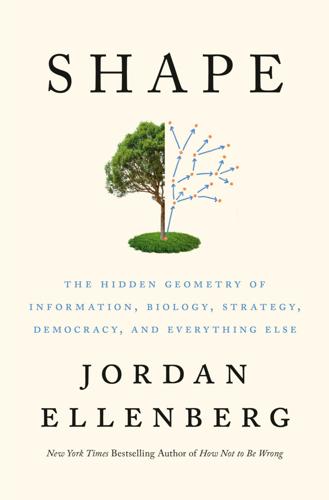
Shape: The Hidden Geometry of Information, Biology, Strategy, Democracy, and Everything Else
by
Jordan Ellenberg
Published 14 May 2021
And if you change the weights on the lines—that is, if you turn the fourteen knobs—you change the strategy. The picture gives you a fourteen-dimensional landscape you can explore, looking for a strategy that fits best whatever data you already have. If you’re finding it hard to imagine what a fourteen-dimensional landscape looks like, I recommend following the advice of Geoffrey Hinton, one of the founders of the modern theory of neural nets: “Visualize a 3-space and say ‘fourteen’ to yourself very loudly. Everyone does it.” Hinton comes from a lineage of high-dimension enthusiasts: his great-grandfather Charles wrote an entire book in 1904 about how to visualize four-dimensional cubes, and invented the word “tesseract” to describe them.* If you’ve seen Dalí’s painting Crucifixion (Corpus Hypercubus), that’s one of Hinton’s visualizations.
…
by Frank Rosenblatt: Frank Rosenblatt, “The perceptron: a probabilistic model for information storage and organization in the brain.” Psychological Review 65, no. 6 (1958): 386. Rosenblatt’s perceptron was a generalization of a less refined mathematical model of neural processing developed in the 1940s by Warren McCulloch and Walter Pitts. “Visualize a 3-space”: Lecture 2c of Geoffrey Hinton’s notes for “Neural Networks for Machine Learning.” Available at www.cs.toronto.edu/~tijmen/csc321/slides/lecture_slides_lec2.pdf. his great-grandfather: For the familial relation between the two Hintons, see K. Onstad, “Mr. Robot,” Toronto Life, Jan. 28, 2018. Chapter 8: You Are Your Own Negative-First Cousin, and Other Maps The geometry of chords: Dmitri Tymoczko, A Geometry of Music (New York: Oxford University Press, 2010).
…
) * The sequence that counts the number of paraffins with more and more carbon atoms is, of course, recorded in the On-Line Encyclopedia of Integer Sequences: it is sequence A000602. * It’s linear algebra that provides us the theory of “vectors” that’s so central to machine learning, and which gave Geoffrey Hinton the wherewithal to describe fourteen-dimensional space as just like a three-dimensional space to which you loudly say “fourteen!” every so often. * Daniel Brown, in his extremely interesting book The Poetry of Victorian Scientists, argues that this poem can be read as addressing Sylvester’s exclusion from the university system on account of his faith, casting Sylvester himself as the “missing member.”
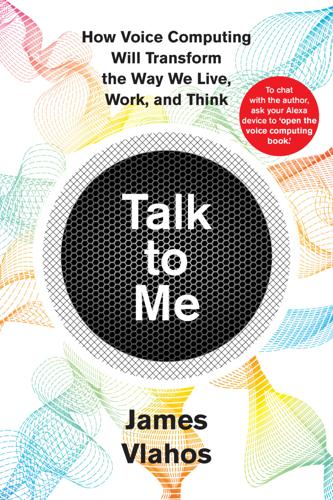
Talk to Me: How Voice Computing Will Transform the Way We Live, Work, and Think
by
James Vlahos
Published 1 Mar 2019
McCulloch and Walter Pitts, “A Logical Calculus of the Ideas Immanent in Nervous Activity,” Bulletin of Mathematical Biophysics 5, (1943): 115–33, https://goo.gl/aFejrr. 87 He called it the Mark I Perceptron: Perceptron information primarily from: Frank Rosenblatt, “The Perceptron: A Probabilistic Model for Information Storage and Organization in the Brain,” Psychological Review 65, no. 6 (1958): 386–408; and “Mark I Perceptron Operators’ Manual,” a report by the Cornell Aeronautical Laboratory, February 15, 1960. 88 “The Navy revealed the embryo”: “New Navy Device Learns By Doing,” New York Times, July 8, 1958, https://goo.gl/Jnf6n9. 89 “Canadian Mafia”: Mark Bergen and Kurt Wagner, “Welcome to the AI Conspiracy: The ‘Canadian Mafia’ Behind Tech’s Latest Craze,” Recode, July 15, 2015, https://goo.gl/PeMPYK. 91 But when Rumelhart, Hinton, and Williams: David Rumelhart et al., “Learning representations by back-propagating errors,” Nature 323 (October 9, 1986): 533–36. 92 The result, Bengio and LeCun announced: Yann LeCun et al., “Gradient-Based Learning Applied to Document Recognition,” Proceedings of the IEEE, November 1998, 1, https://goo.gl/NtNKJB. 92 Toward the end of the 1990s: email from Geoffrey Hinton to author, July 28, 2018. 92 “Smart scientists,” he said: Bergen and Wagner, “Welcome to the AI Conspiracy.” 92 What’s more, they needed more layers: Yoshua Bengio, email to author, August 3, 2018. 92 In 2006 a groundbreaking pair of papers: Geoffrey Hinton and R. R. Salakhutdinov, “Reducing the Dimensionality of Data with Neural Networks,” Science 313 (July 28, 2006): 504–07, https://goo.gl/Ki41L8; and Yoshua Bengio et al., “Greedy Layer-Wise Training of Deep Networks,” Proceedings of the 19th International Conference on Neural Information Processing Systems (2006): 153–60, https://goo.gl/P5ZcV7. 93 Then, in 2012, a team of computer scientists from Stanford and Google Brain: Quoc Le et al., “Building High-level Features Using Large Scale Unsupervised Learning,” Proceedings of the 29th International Conference on Machine Learning, 2012, https://goo.gl/Vc1GeS. 93 The next breakthrough came in 2012: Alex Krizhevsky et al., “ImageNet Classification with Deep Convolutional Neural Networks,” Advances in Neural Information Processing Systems 25 (2012): 1097–105, https://goo.gl/x9IIwr. 94 In 2018 Google announced that one of its researchers: Kaz Sato, “Noodle on this: Machine learning that can identify ramen by shop,” Google blog, April 2, 2018, https://goo.gl/YnCujn. 94 “They said, ‘Okay, now we buy it’”: Tom Simonite, “Teaching Machines to Understand Us,” MIT Technology Review, August 6, 2015, https://goo.gl/nPkpll. 94 But with the efficacy of the technique: Among the many sources consulted for the science of speech recognition and language understanding, some of the most helpful were: Stuart Russell and Peter Norvig, Artificial Intelligence: A Modern Approach (Noida, India: Pearson Education, 2015); Lane Greene, “Finding a Voice,” The Economist, May 2017, https://goo.gl/hss3oL; and Hongshen Chen et al., “A Survey on Dialogue Systems: Recent Advances and New Frontiers,” ACM SIGKDD Explorations Newsletter 19, no. 2 (December 2017), https://goo.gl/GVQUKc. 95 To pinpoint those, an iPhone: “Hey Siri: An On-device DNN-powered Voice Trigger for Apple’s Personal Assistant,” Apple blog, October 2017, https://goo.gl/gWKjQN. 97 But in 2016 IBM and Microsoft independently announced: Allison Linn, “Historic Achievement: Microsoft researchers reach human parity in conversational speech recognition,” Microsoft blog, October 18, 2016, https://goo.gl/4Vz3YF. 98 Apple has patented a technique: “Digital Assistant Providing Whispered Speech,” United States Patent Application by Apple, December 14, 2017, https://goo.gl/3QRddB. 98 In 2016 researchers at Google and Oxford University: Yannis Assael et al., “LipNet: End-to-End Sentence-level Lipreading,” conference paper submitted for ICLR 2017 (December 2016), https://goo.gl/Bhoz7N. 101 Neural networks need much more compact word embeddings: Tomas Mikolov et al., “Efficient Estimation of Word Representations in Vector Space,” proceedings of workshop at ICLR, September 7, 2013, https://goo.gl/gHURjZ. 102 “Deep learning,” he says: Steve Young, interview with author, September 19, 2017. 104 The method, which is known as sequence-to-sequence: Ilya Sutskever et al., “Sequence to Sequence Learning with Neural Networks,” Advances in Neural Information Processing Systems 27 (December 14, 2014), https://goo.gl/U3KtxJ. 105 When Vinyals and Le published the results: Oriol Vinyals and Quoc Le, “A Neural Conversational Model,” Proceedings of the 31st International Conference on Machine Learning 37 (2015): https://goo.gl/sZjDy1. 106 “can home in on the part of the incoming email”: Greg Corrado, “Computer, respond to this email,” Google AI blog, November 3, 2015, https://goo.gl/YHMvnA. 108 “This organic writer, for one, could hardly tell one from the other”: Siddhartha Mukherjee, “The Future of Humans?
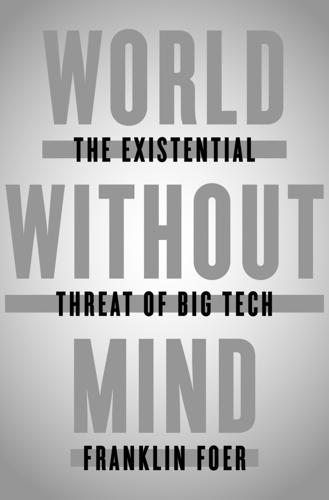
World Without Mind: The Existential Threat of Big Tech
by
Franklin Foer
Published 31 Aug 2017
Google has spearheaded the revival of a concept first explored in the sixties, one that has failed until recently: neural networks, which involve computing modeled on the workings of the human brain. Algorithms replicate the brain’s information processing and its methods for learning. Google has hired the British-born professor Geoff Hinton, who has made the greatest progress in this direction. It also acquired a London-based company called DeepMind, which created neural networks that taught themselves, without human instruction, to play video games. Because DeepMind feared the dangers of a single company possessing such powerful algorithms, it insisted that Google never permit its work to be militarized or sold to intelligence services.
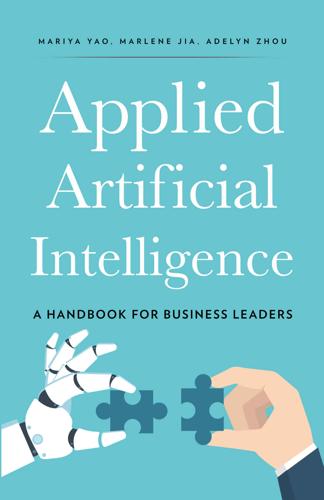
Applied Artificial Intelligence: A Handbook for Business Leaders
by
Mariya Yao
,
Adelyn Zhou
and
Marlene Jia
Published 1 Jun 2018
This is a good way to get international talent to work on your problem and will also build your reputation as a company that supports AI. As with any industry, like attracts like. Dominant tech companies build strong AI departments by hiring superstar leaders. Google and Facebook attracted university professors and AI research pioneers such as Geoffrey Hinton, Fei-Fei Li, and Yann LeCun with plum appointments and endless resources. These professors either take a sabbatical from their universities or split their time between academia and industry. Effective Alternatives to Hiring Despite your best efforts, hiring new AI talent may prove to be slow or impossible.
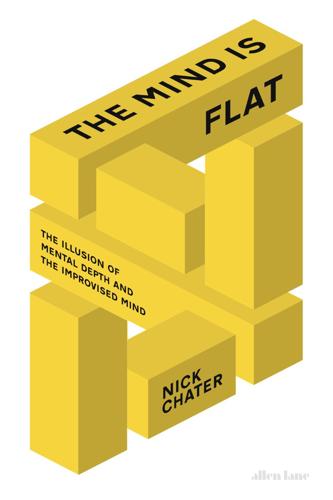
The Mind Is Flat: The Illusion of Mental Depth and the Improvised Mind
by
Nick Chater
Published 28 Mar 2018
This requires a systematic rethink of large parts of psychology, neuroscience and the social sciences, but it also requires a radical shake-up of how each of us thinks about ourselves and those around us. I have had a lot of help writing this book. My thinking has been shaped by decades of conversations with Mike Oaksford and Morten Christiansen, and discussions over the years with John Anderson, Gordon Brown, Ulrike Hahn, Geoff Hinton, Richard Holton, George Loewenstein, Jay McClelland, Adam Sanborn, Jerry Seligman, Neil Stewart, Josh Tenenbaum and James Tresilian, and so many other wonderful friends and colleagues. Writing this book has been supported by generous financial support through grants from the ERC (grant 295917-RATIONALITY), the ESRC Network for Integrated Behavioural Science (grant number ES/K002201/1) and the Leverhulme Trust (grant number RP2012-V-022).
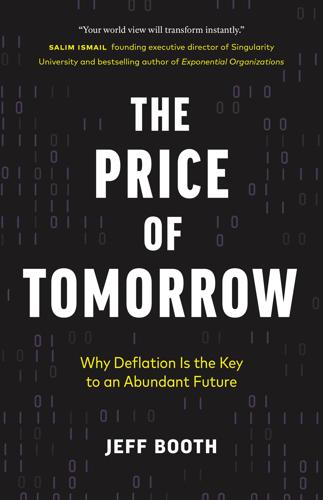
The Price of Tomorrow: Why Deflation Is the Key to an Abundant Future
by
Jeff Booth
Published 14 Jan 2020
No longer constrained by human knowledge, it took only three days of the computer playing itself to best previous AlphaGo versions developed by top researchers and it continued to improve from there. It mastered the masters, then mastered itself, and kept on going. How does this relate to our own intelligence? Geoffrey Hinton has long been trying to understand how our brains work. Hinton, the “godfather of deep learning,” is a cognitive psychologist and computer scientist who moved to Canada because of its continued research funding through the second AI winter in the early 1990s. He currently divides his time between his work at Google and as a professor at the University of Toronto.
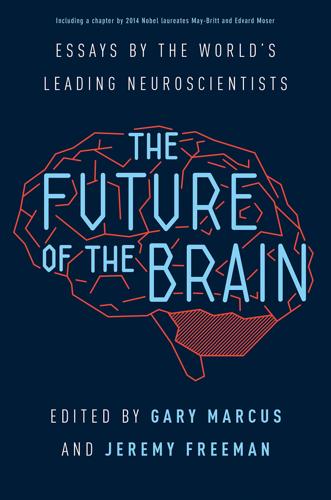
The Future of the Brain: Essays by the World's Leading Neuroscientists
by
Gary Marcus
and
Jeremy Freeman
Published 1 Nov 2014
But as Steven Pinker and I showed, the details were rarely correct empirically; more than that, nobody was ever able to turn a neural network into a functioning system for understanding language. Today neural networks have finally found a valuable home—in machine learning, especially in speech recognition and image classification, due in part to innovative work by researchers such as Geoff Hinton and Yann LeCun. But the utility of neural networks as models of mind and brain remains marginal, useful, perhaps, in aspects of low-level perception but of limited utility in explaining more complex, higher-level cognition. Why is the scope of neural networks so limited if the brain itself is so obviously a neural network?

The Myth of Artificial Intelligence: Why Computers Can't Think the Way We Do
by
Erik J. Larson
Published 5 Apr 2021
Classical AI scientists dismissed these as “shallow” or “empirical,” because statistical approaches using data didn’t use knowledge and couldn’t handle reasoning or planning very well (if at all). But with the web providing the much-needed data, the approaches started showing promise. The deep learning “revolution” began around 2006, with early work by Geoff Hinton, Yann LeCun, and Yoshua Bengio. By 2010, Google, Microsoft, and other Big Tech companies were using neural networks for major consumer applications such as voice recognition, and by 2012, Android smartphones featured neural network technology. From about this time up through 2020 (as I write this), deep learning has been the hammer causing all the problems of AI to look like a nail—problems that can be approached “from the ground up,” like playing games and recognizing voice and image data, now account for most of the research and commercial dollars in AI.

Futureproof: 9 Rules for Humans in the Age of Automation
by
Kevin Roose
Published 9 Mar 2021
They are either unaware of or unconcerned with the ground-level consequences of their work, and although they might pledge to care about the responsible use of AI, they’re not doing anything to slow down or consider how the tools they build could enable harm. Trust me, I would love to be an AI optimist again. But right now, humans are getting in the way. Two The Myth of the Robot-Proof Job We humans are neural nets. What we can do, machines can do. —Geoffrey Hinton, computer scientist and AI pioneer A few years ago, I got invited to dinner with a big group of executives. It was an unusually fancy spread—expensive Champagne, foie gras, beef tenderloin—and as our entrées arrived, the conversation turned, as it often does in these circles, to AI and automation.
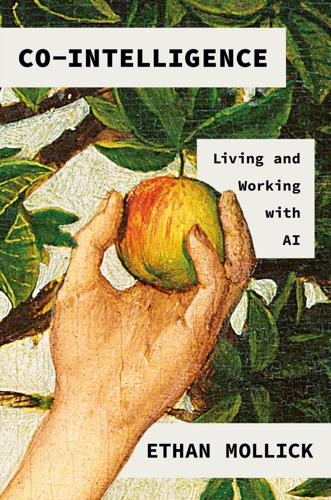
Co-Intelligence: Living and Working With AI
by
Ethan Mollick
Published 2 Apr 2024
But the truth is that we don’t know if there is a straight road from today’s LLMs to building a true AGI. And we don’t know if AGI would help or hurt us, or how it would do either. Enough serious experts believe this risk is real that we need to take it seriously. For example, one of the godfathers of AI, Geoffrey Hinton, left the field in 2023, warning of the danger of AI with statements like “It’s quite conceivable that humanity is just a passing phase in the evolution of intelligence.” Other AI researchers speak of their p(doom), the chance that AI leads to human extinction. If the AI “doomers” are right, large-scale regulation to halt AI development forever is the only option—as unlikely as that seems.

How the Mind Works
by
Steven Pinker
Published 1 Jan 1997
But that poses a problem the perceptron did not have to worry about: how to adjust the connections from the input units to the hidden units. It is problematic because the teacher, unless it is a mind reader, has no way of knowing the “correct” states for the hidden units, which are sealed inside the network. The psychologists David Rumelhart, Geoffrey Hinton, and Ronald Williams hit on a clever solution. The output units propagate back to each hidden unit a signal that represents the sum of the hidden unit’s errors across all the output units it connects to (“you’re sending too much activation,” or “you’re sending too little activation,” and by what amount).
…
The mind needs a representation for the proposition itself. In this example, the model needs an extra layer of units—most straightforwardly, a layer dedicated to representing the entire proposition, separately from the concepts and their roles. The bottom of page 121 shows, in simplified form, a model devised by Geoffrey Hinton that does handle the sentences. The bank of “proposition” units light up in arbitrary patterns, a bit like serial numbers, that label complete thoughts. It acts as a superstructure keeping the concepts in each proposition in their proper slots. Note how closely the architecture of the network implements standard, language-like mentalese!
…
Simulated evolution gives the networks a big head start in their learning careers. So evolution can guide learning in neural networks. Surprisingly, learning can guide evolution as well. Remember Darwin’s discussion of “the incipient stages of useful structures”—the what-good-is-half-an-eye problem. The neural-network theorists Geoffrey Hinton and Steven Nowlan invented a fiendish example. Imagine an animal controlled by a neural network with twenty connections, each either excitatory (on) or neutral (off). But the network is utterly useless unless all twenty connections are correctly set. Not only is it no good to have half a network; it is no good to have ninety-five percent of one.
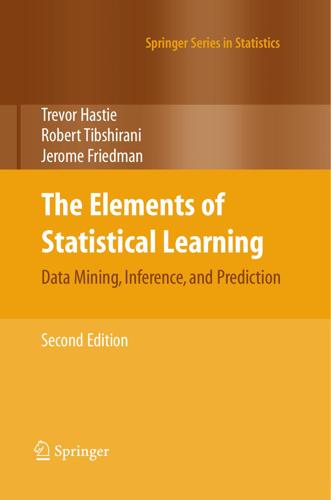
The Elements of Statistical Learning (Springer Series in Statistics)
by
Trevor Hastie
,
Robert Tibshirani
and
Jerome Friedman
Published 25 Aug 2009
Just as we have learned a great deal from researchers outside of the field of statistics, our statistical viewpoint may help others to better understand different aspects of learning: There is no true interpretation of anything; interpretation is a vehicle in the service of human comprehension. The value of interpretation is in enabling others to fruitfully think about an idea. –Andreas Buja We would like to acknowledge the contribution of many people to the conception and completion of this book. David Andrews, Leo Breiman, Andreas Buja, John Chambers, Bradley Efron, Geoffrey Hinton, Werner Stuetzle, and John Tukey have greatly influenced our careers. Balasubramanian Narasimhan gave us advice and help on many computational problems, and maintained an excellent computing environment. Shin-Ho Bang helped in the production of a number of the figures. Lee Wilkinson gave valuable tips on color production.
…
Compute the leading principal component and factor analysis directions. Hence show that the leading principal component aligns itself in the maximal variance direction X3 , while the leading factor essentially ignores the uncorrelated component X3 , and picks up the correlated component X2 + X1 (Geoffrey Hinton, personal communication). Ex. 14.16 Consider the kernel principal component procedure outlined in Section 14.5.4. Argue that the number M of principal components is equal to the rank of K, which is the number of non-zero elements in D. Show that the mth component zm (mth column of Z) can be written (up to PN centering) as zim = j=1 αjm K(xi , xj ), where αjm = ujm /dm .
…
The restricted form of this model simplifies the Gibbs sampling for estimating the expectations in (17.37), since the variables in each layer are independent of one another, given the variables in the other layers. Hence they can be sampled together, using the conditional probabilities given by expression (17.30). The resulting model is less general than a Boltzmann machine, but is still useful; for example it can learn to extract interesting features from images. 5 We thank Geoffrey Hinton for assistance in the preparation of the material on RBMs. 644 17. Undirected Graphical Models By alternately sampling the variables in each layer of the RBM shown in Figure 17.6, it is possible to generate samples from the joint density model. If the V1 part of the visible layer is clamped at a particular feature vector during the alternating sampling, it is possible to sample from the distribution over labels given V1 .

Human + Machine: Reimagining Work in the Age of AI
by
Paul R. Daugherty
and
H. James Wilson
Published 15 Jan 2018
Many other researchers provided relevant findings and insights that enriched our thinking, including Mark Purdy, Ladan Davarzani, Athena Peppes, Philippe Roussiere, Svenja Falk, Raghav Narsalay, Madhu Vazirani, Sybille Berjoan, Mamta Kapur, Renee Byrnes, Tomas Castagnino, Caroline Liu, Lauren Finkelstein, Andrew Cavanaugh, and Nick Yennaco. We owe a special debt to the many visionaries and pioneers who have blazed AI trails and whose work has inspired and informed us, including Herbert Simon, John McCarthy, Marvin Minsky, Arthur Samuel, Edward Feigenbaum, Joseph Weizenbaum, Geoffrey Hinton, Hans Moravec, Peter Norvig, Douglas Hofstadter, Ray Kurzweil, Rodney Brooks, Yann LeCun, and Andrew Ng, among many others. And huge gratitude to our colleagues who provided insights and inspiration, including Nicola Morini Bianzino, Mike Sutcliff, Ellyn Shook, Marc Carrel-Billiard, Narendra Mulani, Dan Elron, Frank Meerkamp, Adam Burden, Mark McDonald, Cyrille Bataller, Sanjeev Vohra, Rumman Chowdhury, Lisa Neuberger-Fernandez, Dadong Wan, Sanjay Podder, and Michael Biltz.
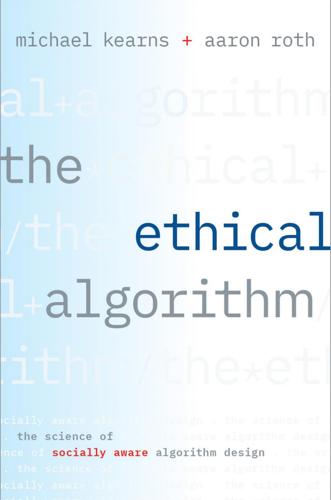
The Ethical Algorithm: The Science of Socially Aware Algorithm Design
by
Michael Kearns
and
Aaron Roth
Published 3 Oct 2019
The technical name for the algorithmic framework we have been describing is a generative adversarial network (GAN), and the approach we’ve outlined above indeed seems to be highly effective: GANs are an important component of the collection of techniques known as deep learning, which has resulted in qualitative improvements in machine learning for image classification, speech recognition, automatic natural language translation, and many other fundamental problems. (The Turing Award, widely considered the Nobel Prize of computer science, was recently awarded to Yoshua Bengio, Geoffrey Hinton, and Yann LeCun for their pioneering contributions to deep learning.) Fig. 21. Synthetic cat images created by a generative adversarial network (GAN), from https://ajolicoeur.wordpress.com/cats. But with all of this discussion of simulated self-play and fake cats, it might seem like we have strayed far from the core topic of this book, which is the interaction between societal norms and values and algorithmic decision-making.
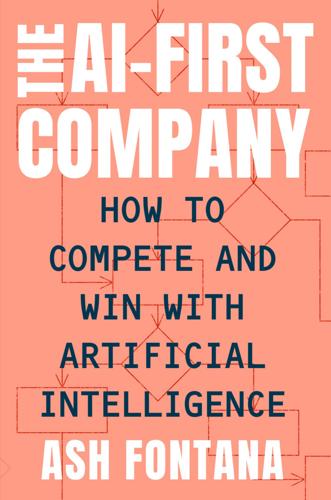
The AI-First Company
by
Ash Fontana
Published 4 May 2021
AI researchers made breakthroughs in stringing neurons together in a network at the start of the millennium. The Canadian computer scientist Yoshua Bengio devised a language model based on a neural network that figured out the next best word to use among all the available words in a language based on where that word usually appeared with respect to other words. Geoffrey Hinton, a British-born computer scientist and psychologist, developed a neural network that linked many layers of neurons together, the precursor to deep learning. Importantly, researchers worked to get these neural networks running efficiently on the available computer chips, settling on the chips used for computer graphics because they are particularly good at running many numerical computations in parallel.

Fully Automated Luxury Communism
by
Aaron Bastani
Published 10 Jun 2019
Incredibly, it has a self-teaching neural network which constantly adds to its knowledge of how the heart works with each new case it examines. It is in areas such as this where automation will make initial incursions into medicine, boosting productivity by accompanying, rather than replacing, existing workers. Yet such systems will improve with each passing year and some, like ‘godfather of deep learning’ Geoffrey Hinton, believe that medical schools will soon stop training radiologists altogether. Perhaps that is presumptuous – after all, we’d want a level of quality control and maybe even the final diagnosis to involve a human – but even then, this massively upgraded, faster process might need one trained professional where at present there are dozens, resulting in a quicker, superior service that costs less in both time and money.
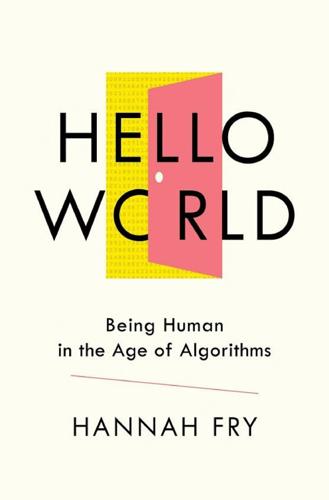
Hello World: Being Human in the Age of Algorithms
by
Hannah Fry
Published 17 Sep 2018
Neural networks have been around since the middle of the twentieth century, but until quite recently we’ve lacked the widespread access to really powerful computers necessary to get the best out of them. The world was finally forced to sit up and take them seriously in 2012 when computer scientist Geoffrey Hinton and two of his students entered a new kind of neural network into an image recognition competition.12 The challenge was to recognize – among other things – dogs. Their artificially intelligent algorithm blew the best of its competitors out of the water and kicked off a massive renaissance in deep learning.
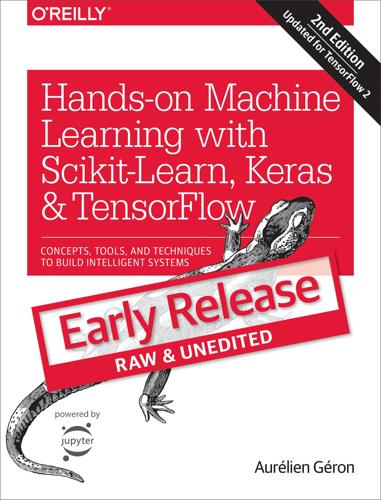
Hands-On Machine Learning With Scikit-Learn, Keras, and TensorFlow: Concepts, Tools, and Techniques to Build Intelligent Systems
by
Aurelien Geron
Published 14 Aug 2019
However, after a while the validation error stops decreasing and actually starts to go back up. This indicates that the model has started to overfit the training data. With early stopping you just stop training as soon as the validation error reaches the minimum. It is such a simple and efficient regularization technique that Geoffrey Hinton called it a “beautiful free lunch.” Figure 4-20. Early stopping regularization Tip With Stochastic and Mini-batch Gradient Descent, the curves are not so smooth, and it may be hard to know whether you have reached the minimum or not. One solution is to stop only after the validation error has been above the minimum for some time (when you are confident that the model will not do any better), then roll back the model parameters to the point where the validation error was at a minimum.
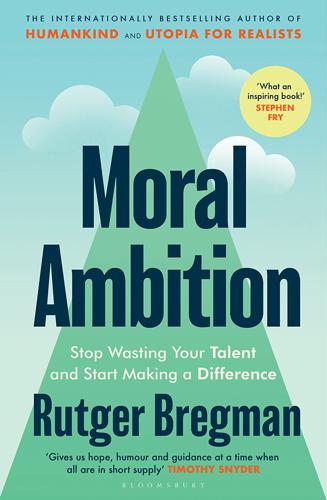
Moral Ambition: Stop Wasting Your Talent and Start Making a Difference
by
Bregman, Rutger
Published 9 Mar 2025
A former student of Albert Einstein’s, the 35-year-old physicist Leó Szilárd, hit on the idea of a nuclear chain reaction the very next day. What’s the difference between the development of the atomic bomb and of artificial intelligence? Well, there’s not one single Manhattan Project but a number of commercial labs racing to develop the most powerful ai possible. The Nobel-prizewinning computer scientist Geoffrey Hinton, considered one of the godfathers of AI, voiced his concerns as early as 2015 that the innovation would be used to terrorise people. ‘Then why are you doing the research?’ someone asked him. ‘I could give you the usual arguments,’ he said. ‘But the truth is that the prospect of a discovery is too sweet.’20 And then there’s a third existential threat to humankind: pathogens that escape from a laboratory.

Four Battlegrounds
by
Paul Scharre
Published 18 Jan 2023
His career covered computer-assisted detection applications in medicine and national security, from improving 3D mammography to remotely scanning cargo containers coming into U.S. ports for contraband. He was doing deep learning with CPUs to map mouse brains before what he referred to as “the Big Bang” in 2012, when Alex Krizhevsky, Ilya Sutskever, and Geoffrey Hinton published a paper showing groundbreaking performance on ImageNet. Before then, John explained, “It took a month to train” the models he was using and “error rates were poor.” Yet he said, “The moment ImageNet happens, everybody in the computer vision community changed from whatever they were doing to deep learning, which was appropriate.”
…
: Brett Darcey, interview by author, October 6, 2021. 250Training safe and robust AI agents: Jack Clark and Dario Amodei, “Faulty Reward Functions in the Wild,” OpenAI Blog, December 21, 2016, https://openai.com/blog/faulty-reward-functions/; Victoria Krakovna et al., “Specification Gaming: the Flip Side of AI Ingenuity,” Deepmind Blog, April 21, 2020, https://deepmind.com/blog/article/Specification-gaming-the-flip-side-of-AI-ingenuity. 250Micro Air Vehicle Lab (MAVLab): Micro Air Vehicle Lab—TUDelft (website), 2021, https://mavlab.tudelft.nl/. 250“mix of neural networks and control theory”: Federico Paredes, interview by author, January 15, 2019. 250“for a lot of what we want to do”: Chuck Howell, interview by author, May 25, 2021. 251“model distillation”: Geoffrey Hinton, Oriol Vinyals, and Jeff Dean, Distilling the Knowledge in a Neural Network (arXiv.org, March 9, 2015), https://arxiv.org/pdf/1503.02531.pdf 251some pharmaceuticals that are approved: Paul Gerrard and Robert Malcolm, “Mechanisms of Modafinil: A Review of Current Research,” Neuropsychiatric Disease and Treatment 3, no. 3 (June 2007): 349–64, https://www.ncbi.nlm.nih.gov/pmc/articles/PMC2654794/; PROVIGIL(R) (Modafinil) Tablets [C-IV], package insert, October 2010, https://www.accessdata.fda.gov/drugsatfda_docs/label/2010/020717s030s034s036lbl.pdf; Jonathan Zittrain, “Intellectual Debt: With Great Power Comes Great Ignorance,” Berkman Klein Center, July 24, 2019, https://medium.com/berkman-klein-center/from-technical-debt-to-intellectual-debt-in-ai-e05ac56a502c; Jonathan Zittrain, “The Hidden Costs of Automated Thinking,” New Yorker, July 23, 2019, https://www.newyorker.com/tech/annals-of-technology/the-hidden-costs-of-automated-thinking. 251“We rely on a complex socio-technical system”: Howell, interview. 251necessary processes for AI assurance to establish justified confidence: Pedro A.
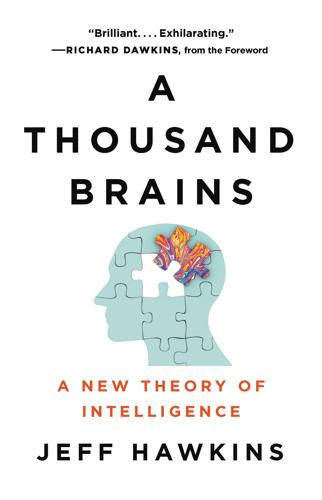
A Thousand Brains: A New Theory of Intelligence
by
Jeff Hawkins
Published 15 Nov 2021
Today, AI and robotics are largely separate fields of research, although the line is starting to blur. Once AI researchers understand the essential role of movement and reference frames for creating AGI, the separation between artificial intelligence and robotics will disappear completely. One AI scientist who understands the importance of reference frames is Geoffrey Hinton. Today’s neural networks rely on ideas that Hinton developed in the 1980s. Recently, he has become critical of the field because deep learning networks lack any sense of location and, therefore, he argues, they can’t learn the structure of the world. In essence, this is the same criticism I am making, that AI needs reference frames.
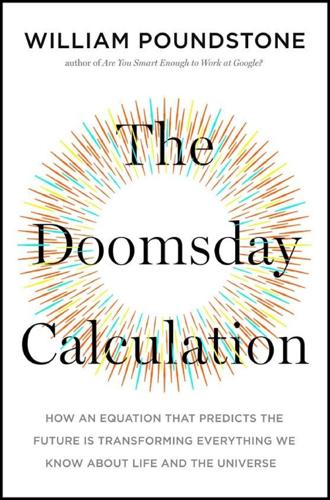
The Doomsday Calculation: How an Equation That Predicts the Future Is Transforming Everything We Know About Life and the Universe
by
William Poundstone
Published 3 Jun 2019
In 2014 Google paid more than $500 million for the British AI start-up Deep Mind. Corporate parent Alphabet is establishing well-funded AI centers across the globe. “I don’t buy into the killer robot [theory],” Google director of research Peter Norvig told CNBC. Another Google researcher, the psychologist and computer scientist Geoffrey Hinton, said, “I am in the camp that it is hopeless.” Mark Zuckerberg and several Facebook executives went so far as to stage an intervention for Musk, inviting him to dinner at Zuckerberg’s house so they could ply him with arguments that AI is okay. It didn’t work. Ever since, Musk and Zuckerberg have waged a social media feud on the topic.
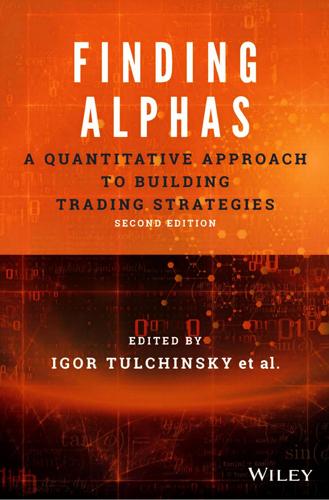
Finding Alphas: A Quantitative Approach to Building Trading Strategies
by
Igor Tulchinsky
Published 30 Sep 2019
Another alternative is FloatBoost, which incorporates the backtracking mechanism of floating search and repeatedly performs a backtracking to remove unfavorable weak classifiers after a new weak classifier is added by AdaBoost; this ensures a lower error rate and reduced feature set at the cost of about five times longer training time. Deep Learning Deep learning (DL) is a popular topic today – and a term that is used to discuss a number of rather distinct things. Some data scientists think DL is just a buzz word or a rebranding of neural networks. The name comes from Canadian scientist Geoffrey Hinton, who created an unsupervised method known as the restricted Boltzmann machine (RBM) for pretraining NNs with a large number of neuron layers. That was meant to improve on the backpropagation training method, but there is no strong evidence that it really was an improvement. Another direction in deep learning is recurrent neural networks (RNNs) and natural language processing.
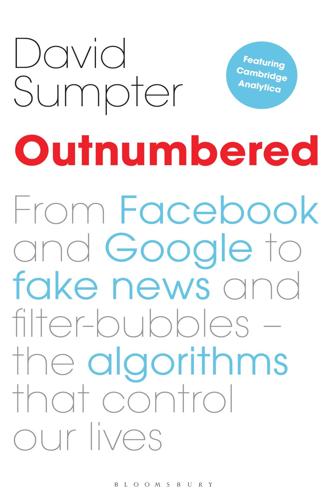
Outnumbered: From Facebook and Google to Fake News and Filter-Bubbles – the Algorithms That Control Our Lives
by
David Sumpter
Published 18 Jun 2018
They realised that convolutional neural networks solved problems at the heart of their businesses. An algorithm that can automatically recognise our friends’ faces, our favourite cute animals and the exotic places that we have visited can allow these companies to better target our interests. Alex and his PhD supervisor, Geoffrey Hinton, were recruited by Google. The following year, one of the competition winners, Rob Fergus, was offered a position at Facebook. In 2014, Google put together its own winning team, and promptly recruited Oxford PhD student Karen Simonyan, who came in second place. In 2015, it was Microsoft researcher Kaiming He and his colleagues who took the prize.

I, Warbot: The Dawn of Artificially Intelligent Conflict
by
Kenneth Payne
Published 16 Jun 2021
Connectionism redux Even with symbolic logic dominant, research on connectionist AI continued in the background. Some of today’s superstar researchers began academic life toiling away in what was often seen as a relatively unglamorous backwater. Facebook’s Yann LeCun spent the late 1980s, working on ConvNets, a neural network specialised in visual tasks. Geoffrey Hinton, another titan of the field today, was also plugging away on neural networks in the 1980s—making important contributions to a vital breakthrough in the maths underpinning some of today’s connectionism. In the last decade, though, these relative outsiders have emphatically moved to the mainstream.

Driverless: Intelligent Cars and the Road Ahead
by
Hod Lipson
and
Melba Kurman
Published 22 Sep 2016
A neural network named SuperVision, created by a team of researchers from the University of Toronto, correctly identified objects 85 percent of the time, a phenomenal performance in the world of image-recognition software.9 A drop from a 25 percent to 15 percent error rate might not sound like a lot, but for the computer-vision community, which was used to seeing annual improvements of a fraction of a percent each year, it was like seeing a man run the first four-minute mile. SuperVision’s creators were students Alex Krizhevsky and Ilya Sutskever, and their professor, Geoffrey Hinton. SuperVision was a type of neural network called a convolutional network. Many of the convolutional network’s features were based on techniques laid out more than thirty years earlier by Dr. Fukushima for the Neocognitron. Additional refinements stemmed from work conducted by the research groups of Yann LeCun at NYU, Andrew Ng at Stanford, and Yoshua Bengio at the University of Montreal.
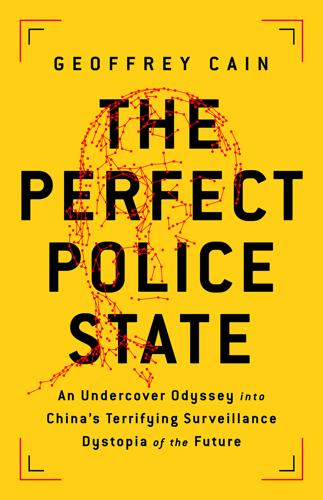
The Perfect Police State: An Undercover Odyssey Into China's Terrifying Surveillance Dystopia of the Future
by
Geoffrey Cain
Published 28 Jun 2021
The Chinese, he said, had less than 10 percent of their population linked up to the internet in 2005, but had rapidly become the world’s most enthusiastic users of social media, mobile apps, and mobile payments.7 In 2011, almost 40 percent of the population, or about 513 million people, had their own internet connections.8 All those internet users were producing the data, through their purchases and clicks, that could train the neural networks to solve myriad tasks, including surveilling the users. The same year, in 2011, a pair of research assistants working for the famed AI researcher Geoffrey Hinton, a computer science professor at the University of Toronto and Google AI researcher, made a hardware breakthrough that made these advances possible. The researchers realized they could repurpose graphics processing units (GPUs), the components installed in devices that allowed for advances in computer game graphics, to improve the processing speeds of a deep neural net.9 With GPUs, AI developers could utilize the same techniques for displaying shapes and images on a computer screen, and use them to train a neural network in finding patterns.

Code Dependent: Living in the Shadow of AI
by
Madhumita Murgia
Published 20 Mar 2024
These included some of the respected computer scientists I had come across in my readings on data colonialism, researchers such as Timnit Gebru, Emily Bender and Deborah Raji.13 They were worried people were missing the real, human harms enacted by these AI systems, in the pursuit of some foolhardy dream of creating a super-intelligent machine. Others like Stuart Russell and Geoffrey Hinton worried that AI was advancing too quickly, without enough knowledge or careful thought about how to design advanced systems that also protect human safety in the long term. Apart from ethical concerns, there were more prosaic ones too. Creative professionals, from writers to voice actors and visual artists, were suddenly being faced with mutant versions of their craft that were cheaper and quicker to create.14 The idea of a machine that ingests and rehashes the world’s creativity wasn’t particularly palatable to them.

Heart of the Machine: Our Future in a World of Artificial Emotional Intelligence
by
Richard Yonck
Published 7 Mar 2017
One of the reasons for this was that pattern recognition technology and other branches of artificial intelligence had already changed so much in the short time since the software had first been built. For instance, though artificial neural networks (ANNs) had fallen out of favor since the 1990s, two important papers on machine learning by Geoffrey Hinton and Ruslan Salakhutdinov in 2006 presented major improvements that returned ANNs to the forefront of AI research.3 Their work and that of others introduced important new methods for setting up and training many-layered neural networks that would go on to transform entire fields. From voice recognition and language translation to image search and fraud detection, these new methods began to be used seemingly everywhere.

This Is for Everyone: The Captivating Memoir From the Inventor of the World Wide Web
by
Tim Berners-Lee
Published 8 Sep 2025
For his part, machine-learning pioneer Andrew Ng has compared discussion of AI risk to worrying about overpopulation on Mars. But there are others, including some of the world’s most eminent computer scientists, who are beginning to worry. Of the three men awarded the Turing Prize for AI research in 2018, only Yann LeCun is comfortable with the risks. His co-winners, Yoshua Bengio and Geoffrey Hinton, are wary. They are also currently the two most cited computer scientists of all time. I think we should listen to Yoshua and Geoffrey. Sci-fi (and particularly Isaac Asimov) has trained us to think that we can simply give AI rules, like ‘don’t kill a human being’, and it will obey. But the neural net systems don’t work that way; they aren’t rules-based, and the complexity of their behaviour will soon approach our own.

Rise of the Robots: Technology and the Threat of a Jobless Future
by
Martin Ford
Published 4 May 2015
Researchers at Facebook have likewise developed an experimental system—consisting of nine levels of artificial neurons—that can correctly determine whether two photographs are of the same person 97.25 percent of the time, even if lighting conditions and orientation of the faces vary. That compares with 97.53 percent accuracy for human observers.9 Geoffrey Hinton of the University of Toronto, one of the leading researchers in the field, notes that deep learning technology “scales beautifully. Basically you just need to keep making it bigger and faster, and it will get better.”10 In other words, even without accounting for likely future improvements in their design, machine learning systems powered by deep learning networks are virtually certain to see continued dramatic progress simply as a result of Moore’s Law.

Rage Inside the Machine: The Prejudice of Algorithms, and How to Stop the Internet Making Bigots of Us All
by
Robert Elliott Smith
Published 26 Jun 2019
The winner of the game is the player who captures the largest territory of the board, based on various scoring rules that evaluate the territories occupied by the stones.14 Although it has simple elements and rules, Go is considered one of the most intellectually challenging games ever devised, with a complexity that dwarfs Chess. Thus, it was a great surprise when, in 2016, AlphaGo beat South Korean Go grandmaster Lee Sedol four-out-of-five times and was declared the winner in that five-game match.15 It was a victory that no one thought possible for an algorithm, prompting Geoffrey Hinton, professor and senior Google AI researcher, to rather ambitiously explain the victory’s significance to a questioning reporter thus:16 It relies on a lot of intuition. The really skilled players just sort of see where a good place to put a stone would be. They do a lot of reasoning as well, which they call reading, but they also have very good intuition about where a good place to go would be, and that’s the kind of thing that people just thought computers couldn’t do.
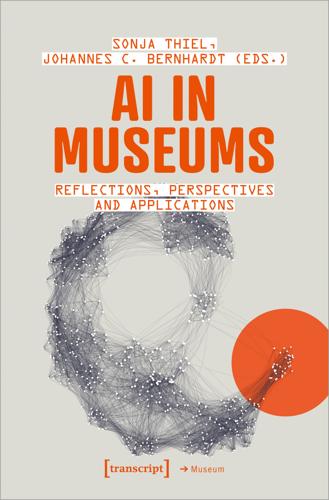
AI in Museums: Reflections, Perspectives and Applications
by
Sonja Thiel
and
Johannes C. Bernhardt
Published 31 Dec 2023
New York/London, Routledge, 386–407. https://doi.org/10.4324/9780429505188 -33. Kirschenbaum, Matthew (2023). Prepare for the Textpocalypse. The Atlantic, 8 March 2023. https://www.theatlantic.com/technology/archive/2023/03/ai-chat gpt-writing-language-models/673318/. LeCun, Yann/Bengio, Yoshua /Geoffrey Hinton (2015). Deep Learning. Nature 521.7553, 436–44. https://doi.org/10.1038/nature14539. Moretti, Franco (2013). Distant Reading. London/New York, Verso. https://doi.org/1 0.3366/ccs.2013.0105. 29 Why AI Cannot Think A Theoretical Approach Daniel M. Feige In June 2022, Blake Lemoine, then an employee at Google, published a sensational announcement: According to him, LaMDA, the chatbot that he was working on, had developed consciousness and feelings (Wertheimer 2022).

Algorithms to Live By: The Computer Science of Human Decisions
by
Brian Christian
and
Tom Griffiths
Published 4 Apr 2016
Cringely, Peter Denning, Raymond Dong, Elizabeth Dupuis, Joseph Dwyer, David Estlund, Christina Fang, Thomas Ferguson, Jessica Flack, James Fogarty, Jean E. Fox Tree, Robert Frank, Stuart Geman, Jim Gettys, John Gittins, Alison Gopnik, Deborah Gordon, Michael Gottlieb, Steve Hanov, Andrew Harbison, Isaac Haxton, John Hennessy, Geoff Hinton, David Hirshliefer, Jordan Ho, Tony Hoare, Kamal Jain, Chris Jones, William Jones, Leslie Kaelbling, David Karger, Richard Karp, Scott Kirkpatrick, Byron Knoll, Con Kolivas, Michael Lee, Jan Karel Lenstra, Paul Lynch, Preston McAfee, Jay McClelland, Laura Albert McLay, Paul Milgrom, Anthony Miranda, Michael Mitzenmacher, Rosemarie Nagel, Christof Neumann, Noam Nisan, Yukio Noguchi, Peter Norvig, Christos Papadimitriou, Meghan Peterson, Scott Plagenhoef, Anita Pomerantz, Balaji Prabhakar, Kirk Pruhs, Amnon Rapoport, Ronald Rivest, Ruth Rosenholtz, Tim Roughgarden, Stuart Russell, Roma Shah, Donald Shoup, Steven Skiena, Dan Smith, Paul Smolensky, Mark Steyvers, Chris Stucchio, Milind Tambe, Robert Tarjan, Geoff Thorpe, Jackson Tolins, Michael Trick, Hal Varian, James Ware, Longhair Warrior, Steve Whittaker, Avi Wigderson, Jacob Wobbrock, Jason Wolfe, and Peter Zijlstra.

Superintelligence: Paths, Dangers, Strategies
by
Nick Bostrom
Published 3 Jun 2014
For many applications, however, the learning that takes place in a neural network is little different from the learning that takes place in linear regression, a statistical technique developed by Adrien-Marie Legendre and Carl Friedrich Gauss in the early 1800s. 24. The basic algorithm was described by Arthur Bryson and Yu-Chi Ho as a multi-stage dynamic optimization method in 1969 (Bryson and Ho 1969). The application to neural networks was suggested by Paul Werbos in 1974 (Werbos 1994), but it was only after the work by David Rumelhart, Geoffrey Hinton, and Ronald Williams in 1986 (Rumelhart et al. 1986) that the method gradually began to seep into the awareness of a wider community. 25. Nets lacking hidden layers had previously been shown to have severely limited functionality (Minsky and Papert 1969). 26. E.g., MacKay (2003). 27.

Nexus: A Brief History of Information Networks From the Stone Age to AI
by
Yuval Noah Harari
Published 9 Sep 2024
We have a moral imperative to realize this promise of new technologies.” Kurzweil is keenly aware of the technology’s potential perils, and analyzes them at length, but believes they could be mitigated successfully.15 Others are more skeptical. Not only philosophers and social scientists but also many leading AI experts and entrepreneurs like Yoshua Bengio, Geoffrey Hinton, Sam Altman, Elon Musk, and Mustafa Suleyman have warned the public that AI could destroy our civilization.16 A 2024 article co-authored by Bengio, Hinton, and numerous other experts noted that “unchecked AI advancement could culminate in a large-scale loss of life and the biosphere, and the marginalization or even extinction of humanity.”17 In a 2023 survey of 2,778 AI researchers, more than a third gave at least a 10 percent chance to advanced AI leading to outcomes as bad as human extinction.18 In 2023 close to thirty governments—including those of China, the United States, and the U.K.

Power and Progress: Our Thousand-Year Struggle Over Technology and Prosperity
by
Daron Acemoglu
and
Simon Johnson
Published 15 May 2023
This makes the customer-service representative less effective and may encourage managers and technologists to seek additional ways of reducing the tasks allocated to them even further. These lessons about human intelligence and adaptability are often ignored in the AI community, which rushes to automate a range of tasks, regardless of the role of human skill. The triumph of AI in radiology is much trumpeted. In 2016 Geoffrey Hinton, cocreator of modern deep-learning methods, Turing Award winner, and Google scientist, suggested that “people should stop training radiologists now. It’s just completely obvious that within five years deep learning is going to do better than radiologists.” Nothing of the sort has yet happened, and demand for radiologists has increased since 2016, for a very simple reason.

Facebook: The Inside Story
by
Steven Levy
Published 25 Feb 2020
He wasn’t thinking about content moderation then, but rather improvement in things like News Feed ranking, better targeting in ad auctions, and facial recognition to better identify your friends in photographs, so you’d engage more with those posts. But the competition to hire AI wizards was fierce. The godfather of deep learning was a British computer scientist working in Toronto named Geoffrey Hinton. He was like the Batman of this new and irreverent form of AI, and his acolytes were a trio of brilliant Robins who individually were making their own huge contributions. One of the Robins, a Parisian named Yann LeCun, jokingly dubbed Hinton’s movement “the Conspiracy.” But the potential of deep learning was no joke to the big tech companies who saw it as a way to perform amazing tasks at scale, everything from facial recognition to instant translation from one language to another.